#I draw a lot of artificer I realize
Text
Another something for a class project!! The teacher has been pushing us to use AI to make our sprites but I don’t want to do that so I’ve been drawing everything myself. Here’s a little Artificer walk

It’s a little messy since I didn’t have much time and I’m not super used to animation yet, but I do like how it turned out
Also here’s a lizard one I did but with a lot choppier movement (it was like 12am and this assignment is due tomorrow)

Galloping crocodile core
#rain world#rain world artificer#rain world fanart#gif#animation#rain world sofanthiel#I draw a lot of artificer I realize#my art
55 notes
·
View notes
Note
crying begging sobbing on my knees for more info on da modcats in your main AU
also what are the other lizards munker takes care of
reminds me, im not sure if the modcat owners are chill with me still continuing to portray their slugcats considering... what happened. (but believe me that i would never fucking do weird stuff to em since i see them practically as other peoples' ocs- this includes shipping them)
but if they do have problems with it, they oughta tell me. id respect their decisions either way. i dont want to further discomfort them. (i also dont want to bring it up to them myself if its okay to still use them. honestly i dont think anyone here wishes to talk about that and its just awkward idk?)
anyway- ill make several of em brief.
dronemaster - created by an iterator? sent to study the new age of civilization and possibly destroy it, but could not. befriends sporecat
sporecat - a gardener and rain deer rider, they help gourmand with agricultural impacts.
beecat - takes care of pups in orphanage. teaches them too. goes on expeditions sometimes to discover certain trees.
wanderer - suns' first slugcat creation. after realizing they delivered a bad pearl to pebbles, they hid away from society in shame until spearmaster discovered their existence and helped them come out of the shadows.
martyr - an echocat who constantly bothers saint after discovering that they're both stuck in the strangest form of a cycle. often torments them but also cares for them.
lancers - orphan siblings who look out for each other. bear some striking resemblance to monk, survivor and hunter but is purely coincidental.
friend and poacher - also siblings who look after each other. have contrasting personalities. friend befriends lizards and poacher kills them. cue the shenanigans. friends of monk.
noircat - friend's love interest but very casual about the relationship. would later befriend survivor.
wingcat - a messenger of sorts who came from a faraway place. decided to hang around seeing a civilization develop. friends with vinci and other prankster cats. attracted to batcat.
batcat - a loner type. appears in the shadows. if edge is a word i can use, i shall, but its up to faeling lol. is friends with wingcat and is attracted to em.
vinci - one of the prankster types who hates pebbles and draws graffiti often on their can.
nomad - a gliding slugcat from a faraway land who has streetsmarts but isnt so smart. feeling ashamed for letting their old village burn, they walk alone- but befriends another slugcat named Arbiter, who accompanies them.
arbiter - nomad's close friend. the creation of an iterator who is long passed. initially wanted to stay their shambled place, but decided to leave and really explore the world with their bestie nomad. is the actual streetsmart and smart, but appears quite menacing and shady.
pearlcat - a strange slugcat from faraway, arriving in a mysterious working train. alongside her is her pup named junior. she wields the power of pearls and would later befriend artificer. she would share the knowledge she has to gourmand.
aaaand a bunch more.
again if you are the owner of a modcat, and you are not comfortable with me depicting them, please absolutely let me know!
also monk takes care a LOT of lizards of varying types and colors.
59 notes
·
View notes
Text
HWS SEA but make it HetaDND

Enjoy these rough sketches because I will literally not come back to them until December. 🥲
(From Back —> Front, L —> R)
VN: Bumped into a couple of Quora answers that discussed archery practice, which got me thinking about Viet as a mounted archer, and I immediately thought of the elephants that the Trung sisters & Ba Trieu rode on. So Ranger: Beastmaster — also what if the elephant was from Thai? 🫣💘 Easily a tank through her mount, but can fight well as a DPS (think OW D.Va).
ID: The thing is he has the fighting style of a Warlock(: Genie?) but the character of a Paladin(: Oath of the Ancients). He’s giving CR Fjord. 😭💞 For sure, TANK.
TH: He’s just a Monk. Debated on his subclass for a long time because he’s a war freak charge-into-the-frontline kind of fighter. Way of Mercy is ironic but I love the imagery of the Merciful Masks (except he gets the khon styles). Way of Shadow — it’s on one possible etymology of Siam (Sanskrit, “dark”). Easily a DPS type.
MY: Druid: Circle of the Moon for the Wild Shape into a Tiger, and as of typing this I just realized the moon motif. Mostly support, but upset him just enough and he’ll easily switch gears.
PH: Bard: College of Swords for the two-weapon fighting style aka arnis/kali/eskrima. Personally, he’s more DPS than support, though as a latter Dirge Singer & Siday fit the bill.
SG: See, the first thing that came to mind was the RO Alchemist class for the Homonculus feature — hence, his companion Fishball. Obviously there’s Artificer: Alchemist for that, but also it would be cool if Fishball is just a “chibi” form of his patron of a water dragon— Warlock: Fathomless. Not to mention Singa would have both high INT and CHA — alas, he’s a Support guy.
(more notes under the cut)
I jokingly called this AU as Dungeons & Drawing Circles, but truth be told I’m not restricting it to being after DND, let alone 5e. Now I’m just throwing hands and calling it a fantasy RPG AU, although out of familiarity, I do refer to DND 5e often. The classes I highlighted above are just there for where I got the inspiration.
I’ve had the occasional “oooh I think [character] would be a [class/es]” hc over the years, but I ended up expanding on the AU as a means of coping with the early months of ECQ. Now there’s so many plot bunnies that I’d summarize as: your og main 8 unwittingly team up for a quest and, over time, they hit a point where they realize that they cannot fight the BBEG alone (or at least just the 8 of them), so they travel around the world recruiting allies a la Suikoden 108 Stars of Destiny.
It’s even got a literal history timeline where preceding events (and characters!!!) are involved with the BBEG and ultimately why the main 8 came together. Think playing a later game in a series where you not only get to meet the playable characters from earlier games, but you get to recruit them.
And I just wanted to draw cool fantasy looks, haha! Nevertheless, nothing is final — especially when I've clearly taken inspiration from some indigenous groups. It's why I shelved this for so long because I need to do more research and it's just not something I have a lot of free time for.
#hetalia#hws philippines#hws indonesia#hws vietnam#hws thailand#hws malaysia#hws singapore#hws sea#fantasy au#fantasy: hetadnd#no reblog because i hate showing sketches <3#posting here because this is a concept blog after all
27 notes
·
View notes
Text




So uhhh. I "went" to the EU art party and when I say "went" I mean I parked Bria in the right spot on an empty map, went afk for like 30 mins debating whether I should actually join or not, and when I finally came back I realized the actual party had already spawned around me (or I into the party? I assume there was a closing map involved somehow) and I ended up getting ridiculously anxious so I just... stood there taking screenshots and drawing without saying a word like a weirdo lmao. Lots of lovely characters though! <3
Of the ones I drew I only know that Runa Gravemourn belongs to @leafofkudzu, not sure who King Kettu or Artificer Gu Sèul belong to though but I did have fun drawing them :>
#vsartparty#i ended up picking three green-themed characters to draw haha#trying to get back into drawing so this was nice#hope you like them! <3
48 notes
·
View notes
Text
I can't stop thinking about House (1977).
Haunted houses are a staple of horror culture. The haunted house goes back centuries, back to oral culture, before these kinds of things were written down. There are hundreds of movies about haunted houses, countless books about them. The Haunting of Hill House, the Amityville Horror, The Shining, the Conjuring, on and on there are examples and variations of the genre, and yet we still go back to the well because there is something so eerily alluring, so endlessly fascinating about the haunted house. Yet, I don’t think there is anything that could have really prepared me for the bizarre and surreal experience of watching House (1977), dir. Nobuhiko Obayashi.
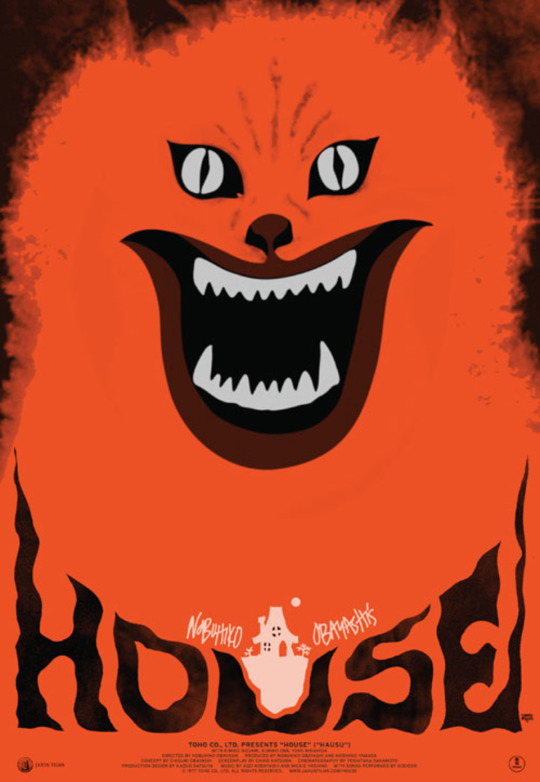
I had heard about it in an offhand fashion from some essayists and critics, but only ever in passing and never in any detail. I think mostly that is because it is impossible to really describe, at least in text. It is a fever dream, a nightmare of color and editing that resists description. About halfway through the movie I had a realization: “Oh, I get it. This is a film made by an insane person.”
I know the word gets thrown around a great deal, and usually in an unserious way. It’s an ableist term, for sure, and one that stigmatizes neurodivergent people. But when you watch this film, you will understand what I mean, because there is no better term for the kind of film that was made here. It was made with remarkable craftsmanship, especially for a film with most likely a shoestring budget. The special effects are pretty silly, especially 46 years later, but there is an air of charming artifice to them that lets you know that the filmmakers were in on the gag. Aside from the effects, however, there is a grasp on genre and subversion that not a lot of films lean into, or they might try and fail to do. House, more than anything, has something to say about haunted houses that not every haunted house story would be willing to do.
Once upon a time...
Spoilers for a film from 1977, obviously. Not that it really matters much, because I’m sure you’ve heard a story like this before.
A girl, unhappy with the fact that her father is getting remarried after her mother died, decides to reach out to her mother’s sister, her aunt. The aunt in turn invites her and her friends to come visit for their summer break. The girl, named Gorgeous, takes her friends, Melody, Sweet, Prof, Kung-fu, Fantasy, and Mac, out to the countryside, where they find her aunt’s house, an idyllic rural mansion. The twist, of course, is that the aunt has been dead for years, and lingers on in our world by haunting her ancestral family’s house.
If any of that seems boring to you, well, congratulations, you’ve heard a scary story before. It’s not the novelty of the story itself that is the draw here, but rather in the way it is told, a way that can only be done through cinema. The imagery of this thing is... well, here’s a few images from the film.




And my personal favorite:

That last one is the severed head of a young girl, Mac, biting the rear end of one of the living girls. We’ll get back to Mac.
Images like this are a big part of why medium is so essential to the arts. Because the “story” is basic, but the film is not. Every great story can usually be boiled down to a simple idea. “Man takes a job at a hotel during offseason.” “Family moves into a house where a grisly murder takes place.” “There’s a doll with a ghost inside it.” Simple, adaptable, and leaves room for a storyteller to leave a mark.
House goes all in on artifice and genre, to the point of farce. At the beginning of the film, you would be forgiven for thinking it was a sunny daytime sit-com, and the girls are even introduced as such halfway through the film! It’s bizarre. It changes tone from “slice of life comedy” to “soap melodrama,” and in brief moments when Kung-fu has any action, “kung-fu movie.” The director took one look at the screenplay and went, “I’ll take everything on the menu.”

You don’t make a movie like House without being in love with film as a medium.
I could go on for a while about the effects, the tonal whiplash, the aesthetics of the thing, and I am very tempted by doing so. I could just list the incredible things this movie does. The set-piece deaths that come in quick succession through the back half of the movie. But that’s best left to someone with a film degree, who can get into the granularity of the medium that I cannot.
No, what makes me really keep thinking about the movie starts with poor, innocent Mac. And once you figure out what the film is doing, you realize that this is not a movie about a haunted house. Haunted house stories seldom are. Haunted houses are about us.
We need to talk about Mac.
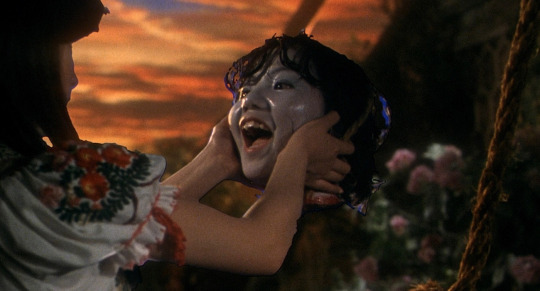
Mac is a girl who likes food. That’s it. That’s all the character she was given. Mac likes to eat, is almost always eating something, and is frequently teased and mocked by her friends for being “fat,” which... well. I don’t know much about Japanese culture, but I do know that there is a rigid enforcement of conformity to certain ideals, which often gets translated to shaming and fatphobia. Mac liked to eat, and so she was the first real punchline of the film. Even her name, Mac, was an intentional joke about eating, a reference the word “stomach,” or even MacDonalds, or some other joke that does not translate from Japanese cleanly. All the girls are given Disney Snow White dwarf naming schemes, but only hers is most clearly a joke.
I was instantly invested in Mac’s wellbeing. Sadly, of course, she was the first one to die.
Mac died first, because she was obviously the odd girl out in a group full of oddballs. She’s the only one that really gets the worst teasing, even worse than Kung-fu, who is mocked for being “manly,” but whose manliness is seen with a kind of awe and reverence, rather than obvious revulsion. Mac was always seen eating something, or in pursuit of food. It is this pursuit of food that in the end results in her death. She went out to the well where she was storing her watermelon, and when a girl goes to check in on her, she is found as only an animated, floating head in the well, a head that makes a joke and then bites a girl on the butt because even in death, she is still hungry. Death cannot keep Mac from being the butt of a joke.
It is in Mac’s shameful death that you realize what the film is doing. Because Mac, though her name was a joke, was just as flatly characterized as everyone else is in the film. All these girls have silly, descriptive names, and all of them have extremely flat, one-dimensional characterizations. Kung-fu is sporty. Sweet is... sweet. Melody plays music, Prof is smart, Fantasy always has her head in the clouds, and Gorgeous is the most beautiful. And all of them, every single one, gets devoured by the house. And in the end, you realize why the house is eating them.
You see, the house is hungry because the ghost who animates it is still waiting, a cautionary tale about putting your own life on hold waiting for a man who will never return. See, the aunt who owns the house was betrothed to a soldier during WWII. She promised that no matter what, she would always be waiting to marry him. When he never returned home, the aunt grows bitter, and dies unmarried. Since then, she preys upon the lives of young, unmarried women in her bridal gown, feasting upon their youth and vigor to sustain her undeath. She literally put her own dreams, her own life, aside for the sake of a man because that is what women are supposed to do in a traditional, patriarchal society.
Once you learn this, you understand why Mac had to die first. All the girls’ names are not only descriptive, they are also flattering to an extent. You could hypothetically ask a man “What are the qualities of a good woman, one you would like to marry?” And the response might be, “I’d like someone smart,” “I’d like someone sweet,” or “I’d like someone beautiful,” etc. So in response, these girls all are simply the embodiment of an idealized feminine attribute, something desired or seen as valuable in a woman. All, of course, except for Mac.
Mac was the joke. She was the most disposable, the one ostracized and teased even by her friends, and also just so happens to embody an attribute that is not classically seen as desirable by patriarchal society. She eats. She consumes and is consumed by consumption. Therefore, she is the first to become consumed by the House.
All the girls meet with a similarly ironic punishment, a Dantesque hell of the film’s making. Sweet is smothered by an avalanche of pillows and mattresses. Gorgeous, sitting in front of the mirror, is swallowed up by vanity and possessed by the ideal itself. Melody’s hands are eaten by a piano. Kung-Fu physically tries to fight the house but is in the end broken by violent means. Prof drowns in a pool of blood as she reads the ghostly aunt’s diary, explaining the tragic end of the House’s owner, and dies in pursuit of knowledge. Fantasy, the final girl, is cradled in the arms of the possessed Gorgeous, and is gently comforted to eternal sleep. The final scene involves Gorgeous meeting her new stepmother in the House, and the cycle will continue anew with this new victim.
Each girl is in the end consumed by the identity which they embody, a grim and grisly vision of what might await them if they ever lived to be adults. The point then is that girlhood and womanhood is only ever seen as an inherently objectifying gaze of the masculine, patriarchal world in which they lived. Mac, the first to go, was but an appetizer, the most visibly mockable victim in the parade of victimhood. The House devours them because society devours us, despite our innocence, despite what qualities we might embody. The aunt was virtuous too, remember. It is virtuous to be patient, to be honest, to be faithful, even unto death. But what if that life is put entirely aside for the betterment of someone else? What is left of the woman left behind to mourn, to grieve? She carries on bearing the weight of expectation. Femininity in relation to patriarchy is a funhouse mirror, warping and distorting what makes us unique, highlighting and capitalizing on our flaws. The ghostly aunt perpetuates the horrifying cycle of predatory expectation, and in turn inflicts those expectations upon the next generation. Gorgeous then the final victim lives on to victimize another.
What is left is simply leftovers
Considering the film made it into the Criterion Collection, it’s safe to say that I’m not the only one who sees the value in House. There is something to the cult horror flick that lingers in the minds of its viewers. Each of us is in our own way haunted by the society that we participate in. Each bears the weight of patriarchy and are either consumed or rejected by it. Both paths lead to destruction.
House is not a hopeful movie, by any means. It's not meant to be a cautionary tale, either. Nobody is virtuous enough to survive, because there is not virtue great enough when the world values those virtues and seeks to consume those who embody them. I do think it is possible in real life to live beyond this cycle, but blaming the girls for dying to it helps nobody. We must instead learn to see why they were swallowed up by the old house and recognize ourselves in the same morality play.
I can recommend watching it, but only if you have a stomach for some out-there gore, silly special effects, idiosyncratic directing choices, and a critical eye. It is definitely the strangest film I’ve seen in years, and if you’re up for strange, you’re in for a treat. Just try not get too hungry.
7 notes
·
View notes
Note
What drew your Tavs to their love interests? Was there an instant connection between them, or was it more of a gradual build-up? What's their favorite things about their respective LIs?
Thank you so much for the ask!! (I swear I'm working on the tents one I just need to actually draw them 😭)
Andis got smacked directly in the face by Cupid watching Wyll's introduction, and Karlach with her golden retriever energy had him at hello. He was immediately drawn to both of their genuineness and sense of fun. Also watching Wyll with the tiefling kids made him swoon. However he does kind of have a crush on everyone new he meets and assumed it would just go away with time so he didn't really make a move beyond his normal platonic affection. His favorite thing about Wyll is his love of a dramatic flair and his unfailingly good heart. His favorite thing about Karlach is her sunny disposition and her love of trying new things. They also all really like dancing and music and that's something they bond over (no I don't have a ballroom dancing thing whatever do you mean,,,) He just loves them so much you guys <- projecting
Salix. Okay salixstarion is really interesting to me because for the majority of their relationship (act 1-mid act 2 at which point they break up) they go through varying degrees of hatred, contempt, and disgust for each other and for their situation. The thing that drew her to him is the fact that he's an elf, meaning she can't use her siren song on him and therefore he poses a serious threat to her safety within the group. The best way I'd describe their arrangement is, they're both playing the exact same game of 5d manipulation chess but they both hate it too much to realize the other person also hates it. Their relationship improves a lot after they break up in act 2 and by the end of the game she's started to develop a genuine crush on him, and him on her, which they then proceed to never address even though they're adventuring together post-game.
Ren and Gale clicked pretty quickly I think. They got talking to him at first because they recognized him as having been their classmate at wizard school, and then continued because of their shared love of their respective crafts. They adore it when he teaches them things about magic and just things in general because they love learning and he's one of the only people who's ever really treated them like they deserve to be taught, if that makes sense. They could spend hours listening to him talk. Ren also loves his artistry when working with the Weave, it reflects their own passion towards the more artistic and beautiful side of their work as an artificer. And he's such a genuinely good and kind person it's hard for them not to fall in love. He's perfect for them is what I'm saying
...I haven't decided who Monty's romancing yet-- I'm just gonna go with whoever tries to fuck him first because that's what's most in character lol. I think his endgame romance is Wyll because uh. Gwaincelot brainworms. My interpretation of it is he'd flirt with Wyll right off the bat, get rejected, drop the subject because he didn't care that much anyway, sleep around with whoever else, and then realize oh fuck I actually genuinely like him what the hell do I do!!! And then they get together sometime during act 3 and are ridiculously cute. I think he does have a brief fling with Gale during the sleep around phase but it's very much no-strings-attached. I really don't think he'd work out with Gale in the long-term. Wyll however I can see being perfect for him.
Cesair isn't romancing anyone I don't think because he's still not over his ex and also this is a playthrough with a dear friend of mine and I won't subject it to that (hi @otherworldlyjukebox ily). But I can see him with Gale, Astarion, or Minthara - he'd definitely end up ascending both of the boys but he'd be so chill with it afterwards. He's used to being subservient so he wouldn't see anything wrong with being Gale's Chosen or Astarion's Consort. There also are the narrative parallels between him and Gale and having had really imbalanced power dynamics in their past relationships. His moral code is really fucky so I could also see him raiding the Grove and recruiting + romancing Minthara if he was guided to that.
5 notes
·
View notes
Text
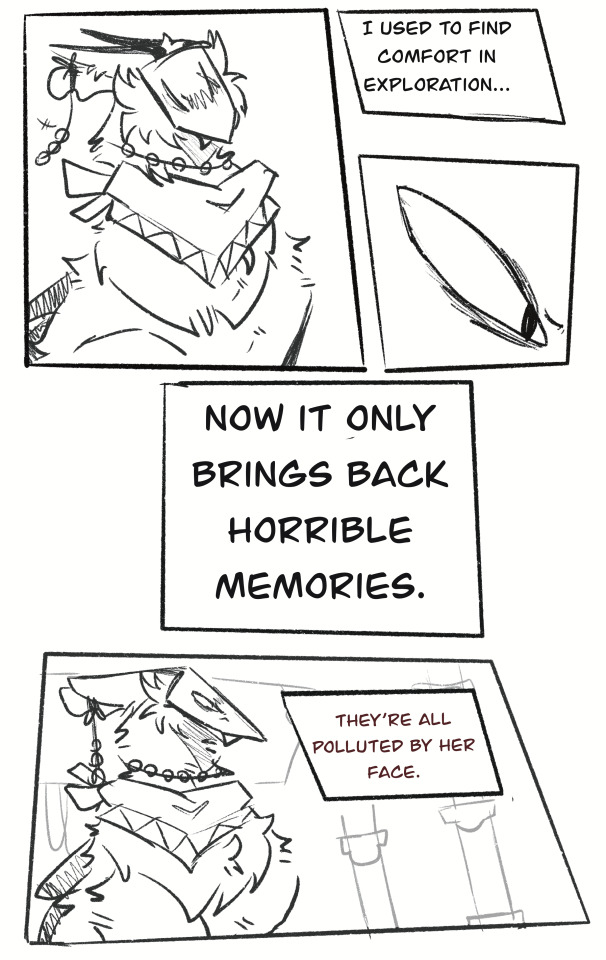
Forgiven (An AU presented by Nob0dyyzz.) P1
Finally got around to actually putting all of my ideas on paper! As you can see, I am a bit of a scavenger enthusiast, so I decided to make an au that allows me to draw a lot of these silly dudes. (I’ll avoid spoiling anything, but the basic idea is that artificer forgave the scavengers after realizing that what she did to them is no better than what they did to her. Probably even worse, to be honest.)
8 notes
·
View notes
Photo
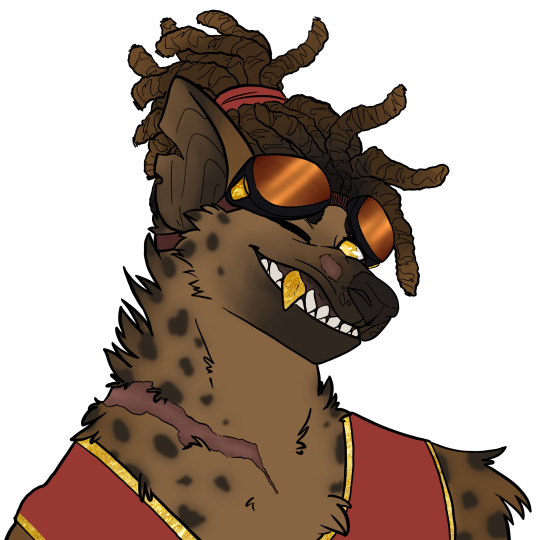
Arekkz Scrapheart and lore building an arms forger
First Picture drawn by the lovely @kobold-kurios
All other images drawn by me.
So let me start this off by saying that I’ve never been THIS in depth with actually writing and drawing lore for a DnD character. Especially during a setting where magic (initially) is limited to clerics and paladins to a disaster in the first season.
Arekkz scrapheart is a Gnoll Artificer in the second season of Kobold’s Bards & Blades campaign. To describe him in a few words: driven, intelligent, exciteable, and intuitive. From his rural tribe to a big city to learn how to be an articifer, he’s managed to make a name for himself as a skilled artisan of the Stonecutter’s guild in Tulpio (the city both groups start in). He also is the sole proprieter of a shop called the Gnoll’n Arms.
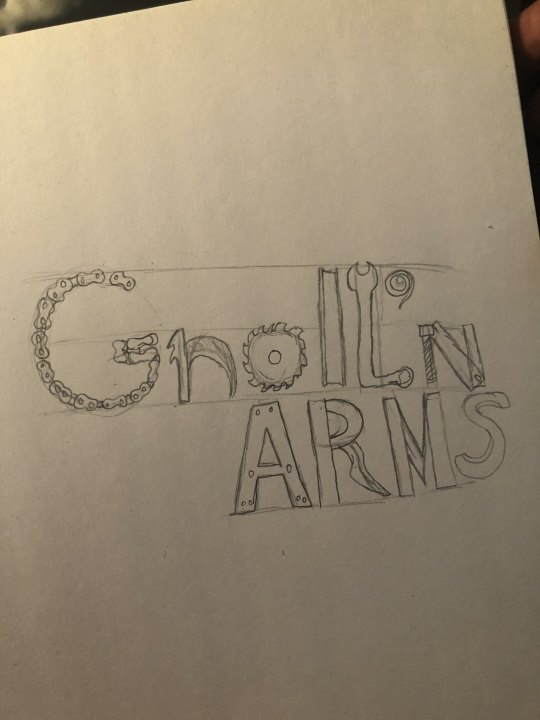
Now getting into the main drive of this post.
Arekkz’s LOVED watching his people forge weapons ever since he was a pup, and took it upon himself to build his first makeshift weapon. And getting to the city of Tulpio, where he’s seen the people there try to replecate magic through alchemy and steampunk technology, his drive in life is to learn more about magic by “sciencing the shit out of it.”
Cue the MO for how he ends up making his weapons for people. Since I was building an artificer in a world without magic, the challenge would be to figure out certain limitations with how he earned his living, and how he cast spells in unconventional ways. I took a lot of inspiration from the usual aesthetics of gnoll weapons, and a lot from Austraila and Junkertown in Overwatch, while still trying to keep it classy enough for customers to want to come and get an excusive of Arekkz’s work. His trademark being bite indents made on the metal before the final treatment process.

The hardest part for me was to make the weapons he make seem almost like he got things from a junkyard and managed to make something not only functional, but aesthetically pleasing in a rough around the edges kind of way. The “boom stick” on the far right being a failure that didn’t mesh well. Not to mention I want to be able to explain just how they work in some instances without having to leave it to DM disgression. And I even started writing some notes about them in character.
Two of them I’m most proud of. First being the Spark Knife

Arekkz personal weapons are all able to help him with his special brand of spellcasting when not being exclusive to other alchemical components and mixtures (or specialized grenades). The Spark Blade in particular coming in a breakthrough for a personal project of his. A way to cast the Green-Flame Blade cantrip. The handle has compression switches on either side of the handle that causes a spark to emmit from just behind the blade that would ignite flammable vapors that (to the current session) Arekkz would spray and release from a vial.
The concept would actually help get an idea for how to make it work with a longer blade. In character, he had trouble replicating what he could do with the Spark Blade due to short swords and longswords either warping, losing sharpness, or not getting the right amoutn of destructive force needed while stress testing them. He ended up going back to the drawing board to figure out what about the Spark Blade worked, and he realized that the metal had enough mass and surface area to survive being used as a “spell focus”, and the materials used managed to keep it from falling apart.
With that in mind, he ended up forgoing the smaller swords and worked with a slab of metal to get a proper greatsword. And the result...
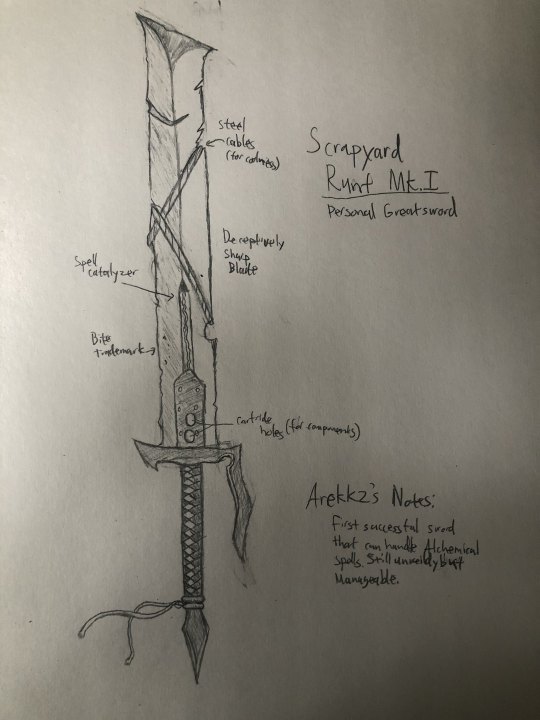
A successful prototype that survived multiple stress tests, and with it, finally given a name: “The Scrapyard Runt Mk.I” (A personal hommage to how HE started with forging). It’s still a work in process, but leaps and bounds farther than what he was able to do before.
I’ll post more weapon sketches as we go deeper into the campaign, as Arekkz’ll probably be commissioned to do work for both HIS party and the Side A party that goes the day before us.
#dnd5e#dnd art#artificer#dnd artificer#blurb#gnoll#Arekkz Scrapheart#weapons#worldbuilding#headcanon#gnoll artificer
22 notes
·
View notes
Text
You know after posting all of my most recent art I realize I draw a lot of aasimars and artificers. I have only played an aasimar once so I have no good reason for drawing them this often, artificers on the other hand….I think someone just needs to take them away from me
23 notes
·
View notes
Photo

finally added details to the height chart for my DND PCs! this is actually relatively big so you can click to enlarge or open in another tab to view full size. here’s the original.
notes! under a cut because it became more than a few
putting details on this really put into perspective just how short niamh is. it’s different when it’s just the basic shapes but making them all actual people and. god. she’s a full foot shorter than zenith. compact!
toby’s not much better off considering how tall i remember neoma and jericho being
i sure like boots in my designs, huh. also fingerless gloves, i actually removed temerity’s here because i couldn’t have three of them in a row. i’m a coward.
syrus and niamh both have the useless belts, though niamh has more lol
chain mail is a fucking pain to draw and i didn’t do a great job here BUT i do like how it ends up looking when i do it right. i did remove it from temerity’s legs and gave him... pants? leggings? need to draw him again from a different angle to figure out what the look is. anyway i covered it up to spare myself some.
the only other time i’ve drawn toby’s armor, i did the pic in grayscale, and tbh i couldn’t figure out another color scheme. partly because now it’s just grayscale in my head. also i like to imagine the lightning on his armor actually lighting up the same blue as the gem (which is an artificer thing and not a feature of the armor as it was made) and i think that’d stand out better on the grayscale.
god syrus’ limbs are just so long
temerity’s face rarely comes out right imo, i’ve gotten him right like. twice maybe. but i think asya’s came out especially cute here!
the color variation here is decent, could use more brighter colors. toby would be more colorful in regular clothes but that’s not their default look so y’know.
four of the six have... partially closed eyes? heavy lidded eyes? idk how that actually translates, but i draw their upper eyelid more on them. i do that a lot in my designs, i just like the look! syrus’ eyes are downturned, asya’s are upturned. syrus and niamh both have the under-eye lashes emphasized more. every time i draw them i remember this one post saying it’s a slutty character design choice. let my kids live.
realizing my two autistic kids here have more neutral/flat default expressions. just how they be.
syrus and toby have my favorite outfits. the super deep V on syrus is fun, and i just love toby’s armor. WISH THEY STILL HAD IT BUT Y’KNOW!!!
i’m not good at symmetry and tend to draw at an angle so the hands don’t quite fall in the same place. one’s higher than the other or gets tucked more behind the leg or both. just something i noticed. need to work on that!
i don’t think they look TOO same-face-y, though that’s something i’ve struggled with. part of my problem again is that i just. can’t tell faces apart SUPER well. i know what shapes i’m going for when i draw a character and i can get the general idea down but i don’t always recreate them properly.
some of their heads are too big, or the proportions of their facial features are off. i can’t fully tell which is which. zenith and toby are the main culprits here.
this feels like a lot of nitpicking my art but the intent is still to discuss the designs as i’m doing so. i’m only partially going off-track.
part of me says i need to utilize patterns more in the clothes i draw, but that’s harder to recreate quickly. toby’s armor took me so long compared to everyone else. simple designs are easy to draw quick and less detailed, as my style often requires. but i like how toby looks here with the details in their armor! everyone else looks so plain next to them in comparison. i’ll think about it.
armor in general is hard for me, that’s why everyone typically dresses in regular clothes in my designs even if they wear armor in-game. i also don’t always look how armor looks so, y’know. clothes are more fun for me to draw.
i need to stop. we’re gonna stop now.
#art tag#reference tag#zenith tag#syrus tag#temerity tag#asya tag#toby tag#niamh tag#dnd tag#dnd ariknauts
2 notes
·
View notes
Text
so this post and this post are drawings from this AU I’ve been working on for like a couple months.
So, Get ready folks! I have many paragraphs worth of political jargon and intricately crafted magic systems for y’all
Also it might be easier to understand this if you are already familiar with D&D and Eberron but I’ve tried to make it understandable for people not aware of the setting.
Also quick warning this story is very mean to Fiddleford.
Okay, First some background:
This world has 5 continents but none of them really matter that much so I won’t get too deep into that. There’s a war that happens later and all you need to know is that O’regan, Califourn’nya and Alitrev’ren are all on one side, and Eldirnapch and Turn’yoc are on the other.
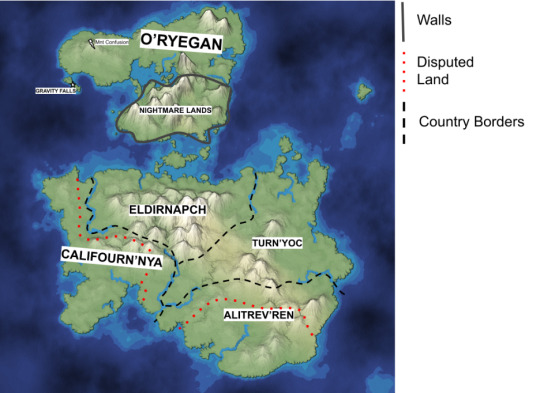
This world also has a lot of portals to the Fey Realm and the elemental planes but portals to the Outer planes (The collection of afterlives and the places where demons/devils/angels hang out) are unstable and dangerous. Fey and Elemental Creatures often hang out in the material plane. The Material plane is very new in relation to all the planes surrounding it, and the further you get from the material plane, the older and scarier the plane is.

Stan and Ford are a set of High Elf twins living in a Traditional high fantasy world in the country of Alitrev’ren. They have a nice childhood until Ford gets rejected from his dream magic school because of Stan’s meddling and Stan gets kicked out.
Stan gets cursed a lot on his way to sucess. Including being cursed to look like a teifling after winning a poker game against a rageful demon. (I know Teiflings have different lore in the actual books, But I’m using youtuber Runesmith’s explanation of them for this, IE: Teiflings are people who made deals with and/or saw the true form of a demon.)
Meanwhile, Ford goes to Backupsmore and meets Fiddleford, a Gnome Artificer. When he graduates he takes a couple years to do independent studies, while Fiddleford goes off and has a family.
They are only reunited when they are both drafted into the war, which had been heating up during this time after the corination of a new, power-hungry and corrupt king on the other side of the war in the kingdom of Eldirnapch. They both end up getting assigned to fix and build warforged. Life’s as good as it can get.
One night while working late, Fiddleford accidentally breaks one of the soul containers used to put souls into warforged bodies. He had been under the impression that the souls he worked with were ones of animals or small bugs, memories wiped and autonomy overtaken by their programming, but he was horrified to find the soul was Human. It began wailing that it had been captured in battle and later killed to be turned into a robot, and it had a family back home, they didn't know much, even their own name, but they remembered being human and were terrified that even that was taken from them. The strength of their emotions began to shatter other soul containers, all monologuing about the lives they left behind when they joined the war.
Fiddleford later was caught trying to escape and had his soul taken/memories wiped to keep him from talking. Ford eventually found this out and struck a deal with Bill to get him out of there. He eventually ended up in the country of O’ryegan, on the island of Gravity falls, where he built a robot body for Fiddleford. Unfortunately, he didn’t remember enough and was afraid of Ford. So he ran away.
Ford was now in debt to Bill, so he built a kind of portal that would be much more stable than any other portals to the outer planes, and be able to switch between diffrent planes to travel to (Which would be a great acheivement for Ford, According to Bill). Bill had claimed to be a creature from limbo, stuck in the Ethereal plane and hoping to go back. In reality, he was a demon from the abyss projecting himself into the Ethereal plane and he was hoping to come into the material world for real.
So Ford built the portal, realized his mistakes, gave Stan the Journal, and then got sucked into the abyss.
The war eventually died down after The country of Eldirnapch opened a portal to the Abyss over O’ryegan and spilt a bunch of demons everywhere, the area in which this happened is now quarantined. Bill would have gone to the event but he was hungover, and good for him too: because all those demons are trapped now.
O’ryegan quit the war because they lost many of their major port cities and so the rest of the continent established a temporary treaty but tensions are high.
Okay, got all that? Just one more thing:
Dipper and Mabel’s parents are scared of growing tension in the war so they send them to the isolated island of Gravity falls, O’ryegan, to visit their great uncle Stan.
SO HERE’S THE FUN PART: THE CHARACTERS
Dipper is a half-elf Wizard with a heavy interest in magic items and divination.
Mabel is a Half-elf bard who has probably practiced illusory magic longer than she’s been able to count.
Stan is a Tiefling/High Elf Arcane-Trickster-Rogue who collects curses at the same rate in which he collects wallets.
Ford is a High Elf Artificer who is honestly more like a really resourceful Wizard. He’s been in the Abyss for 30 years!
Soos is a Human Paladin who is just a really swell guy. He works in The Mystery Shack (Stan’s Adventuring Emporium) as a tour guide and armor salesman.
Wendy is a Wood Elf Barbarian who works at the Mystery Shack as a tour guide and Weapons Salesman. Provides most of the animals used for faux-taxidermy.
And now for a speed round:
The Northwests: Scary Rich Vampire Family. Pacifica is still mortal though.
Gideon: An actual psychic (Stan wears a ring of mind protection just to keep this one kid out of his head.)
Fiddleford: sad warforged with blurry memories and horrible fear of the war. Technological Genius, but a shut-in. Still pretending to be human, but not very good at it.
#gravity falls#gravity falls au#stanford pines#stanley pines#Fiddleford McGucket#old man mcgucket#mabel pines#dipper pines#bill cipher#dungeons and dragons#dungeons dungeons and more dungeons#i have more about the zodiac and the history/nature of gravity falls#but one rant at a time#not a reblog#Mage Monolouges#ask to tag
5 notes
·
View notes
Note
Party dynamics info dump? (this is for a campaign where we are playing the 'bad guys'. Sorry for the length)
Avire - classic bombshell hypersexual vampire lady. Pyromaniac (mom friend)
Entyre ('En-tire') - war vet turned gunslinger mercenary. Only braincell among the group (aloof dad)
Cainan - teen artificer and shit starter, not a bad guy yet (disaster child)
Dagger ('Dag-AIR') - sexy psychic rogue elf who is a prima donna and, despite being a spy and maybe assassin, doesn't know how to keep his mouth shut (suspicious uncle)
Okay so, A has taken it upon herself to take on a mom role to C, despite his many protests. She tells everyone she is his mom. He has used it to shut down a guy who was asking her on a date. C: "oh mother dearest, don't you want to spend time with us tonight?" She was so mad. D is basically A's sugar daddy. Not sure if he likes doting on her or it is to shut her up. She regularly hits on him and he's just having none of it. They are both high cha and have accidentally stepped on each others toes. They draw a lot of attention to our group who is generally trying to lie low. E gets teased a lot by A, and he often has to stop himself from taking her up on her propositions by telling himself, "make smart decisions, Entyre." In the last session, he caved. He's also sort of group dad and the only person with any common sense. E has become protective of C and is this aloof dad/older-brother type. C has a major crush on D, but doesn't realize it because he's never had feelings for anyone (he's a man of science!) So he's just a flustered bi disaster around him. D regularly threatens C and is like "watch yourself, boy. We'll always be a step ahead of you. Get out of here. You are more trouble than you are worth." But as soon as any NPC doubts C, D is like "THIS is the most brilliant boy you will ever meet! How DARE you! He's with us!"
The collective group dynamic is a bunch of bad guys who are out only for themselves, but secretly care about each other but have no idea how to deal with that, or express that in a kind or healthy way. They just make sure the others don't get killed. That's the best we got. Found-family but depraved bastards.
I’m sobbing I love them sm brhsbsy 😭 top-tier family
#haha sorry for not posting for a long time btw#college and work and all that fun stuff#hopefully I will fully come back to life soon !!#not a prompt#asks#oc stuffs#subject-to-roll#i'll queue it with you
14 notes
·
View notes
Photo
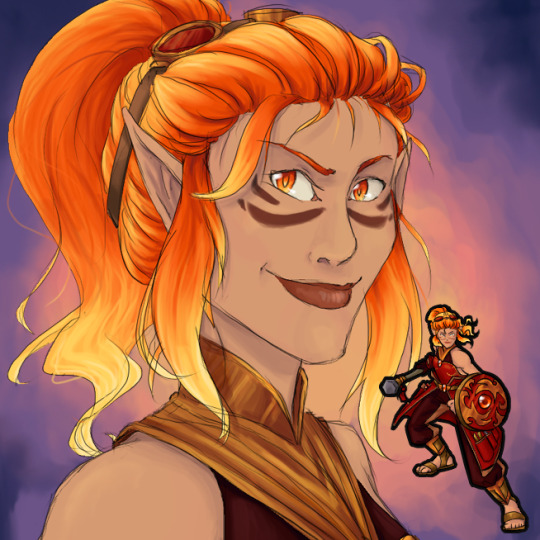

Our D&D campaign is on its last couple sessions, and after some discussion, or DM told us to maybe start thinking about new characters for the next one. It’s tough, because I’ve been playing Alexus for a long time now, and while the interlude with Zmija was wildly successful and I’m very fond of my time with her, she would not be an appropriate character to pick back up. Also, our group composition will be changing, which will give me a chance to be less “jack of all trades”-y cos the other three will maybe be picking up some of that slack.
Anyway our barbarian is going to be playing a ranged rogue, and our warlock is probably playing another caster, which means that between Kattii and I, one of us will be playing a healer, and one of us will be doing our best to tank. She and I have both not really decided on which of us will be filling which role, though, so I’ve been developing two characters simultaneously, in the hopes of either one of us discovering a preference, haha.
Solaris Amahelan is a fire genasi artificer who believes that all things have spirit(s) that can be shaped and molded to be better, and also that you have to keep your things happy or they’ll abandon you when you need them most. She’s peppy, direct, pretty short (5′2-3″ish, a relic of an earlier iteration where she was a gnome, based on one of my WoW alts), and her hair is super light and has a bit of a wave to it so even though it isn’t on fire, it’s always moving in the slightest breeze and very much looks like it could be. Her last name is supposed to sound elvish but in theory it means “sunflower” because there’s a certain other character I only just realized as I was trying to come up with a last name for this post that she draws a lot of inspiration from (though now that I’ve got words for “sun” in both names I’m wondering if I should swap from Solaris to Ember for her first name. Hmmm. We’ll see, I dunno. I’m not super attached to Amahelan yet anyway, maybe something better will come up).
Ceridwyn Rieve, by contrast, is a (scourge) aasimar who at one point when she was younger was sold to a false cult of Ilmater and became very jaded by her time with them and essentially broke ties with her celestial guide or whatever (or at any rate, she ignores the heck out of them). She still had a penchant for healing so she went into military/mercenary work as a medic, and when that gig ended, became a bit of a wandering physician before joining the party. She’s got a big front of “I’m doing this only because it benefits me” that’s mostly designed out of spite (I was told that my party couldn’t see me playing a character that wasn’t nice or happy, lmao). Rieve is the name of a physician in one of the audiobooks I listen to pretty frequently (though I’m probably spelling it incorrectly). She’s also like, somewhere between 6′4″ and 6′6″ which is pretty tall for a lady human but my brain was like “yes. Ceri big. Big Ceri, big good.” lmao
Anyway that was a lot of typing and all to say that one of these characters will eventually go on the trash heap!* but since I had some downtime between the end of bash art stuff and the beginning of money art stuff, I figured I’d get ahead on things and do their character portraits and roll20 tabletop tokens, in case doing so helped me figure out which I wanted to play more (it didn’t, by the way.)
(* and by “trash heap” I mean “kept in reserve and/or just not played” but y’know.)
#xellart#dungeons and dragons#fanart#aasimar#genasi#fire genasi#scourge aasimar#original characters#ember#ceridwyn#Solaris' last name ended up being Amasurya#for what that's worth lol
15 notes
·
View notes
Text
So ive been thinking about one of @unendingliveblogging posts, where toriel is like a super fire mage and it got me thinking. What would all the main characters class and level he in the dark world. Ok so for one we gotta establish the max level and its pretty clear that its gotta be 99 or 100. That being said we can now properly give the characters a level. The characters we are going to be looking at are Toriel, Asgore, Sans, Papyrus, Undyne and Alphys cus why not. Its fair to say as of now that their powers and ranking is similar to the one from undertale. Thus the rankings would be 1) sans(duh) 2) Asgore/Undyne(i think undyne is stronger but some will disagree) 3) papyrus(its implied he has more power then we know of so he goes here) 4) toriel(shes strong but she was to first boss so yea) and 5) alphys(i dont think this is a suprise but yea). The levels for each of them should look something like this: Sans(lv1 but he’s basically maxed level), Asgore(lv90), Undyne(lv90-100 based on the “D” word(determination)), papyrus(lv60-80 because idk I’m making this up on the spot and lv 80 feels a little high idk), Toriel (lv70 it makes sense as theres no way the kids in deltarune even stand a chance in the real world so shes definitely OP in the dark world), and last but not least Alphys(lv50 but probably has robots or something idk). So we know that in the dark world you kinda transform into your desire or something that could help you get what you desire(Noelle turning into a mage that could help her realize her worth and boost her confidence). Starting from Toriel as we are most definitely going to see her in the next chapter, I’m not sure what her desires would be. She seemed to have achieved her teacher dream and she has children she loves with all of her being. If this is the case then shell totally be some sort of wizard. Shell 100% be really similar to Ralsei, but she will have differences. For one she seems to have a book to help her cast spells(whether its just strong spells or all spells, it helps with spell-casting), and two shell have some sort of robe that kind of looks like what she wears in undertale but more robe-y. Shell be able to do some fire magic and maybe a healing spell cus of her kind nature. Moving on… Asgore! Yea so I’m pretty sure he wants to get back with Toriel or maybe its more like he wants a nice family thats together. Mix this with his gardening hobby and hell probably be like a druid or warden. Hell cast awesome forest or flower magic and probably have his cool trident again. I think the warden thing actually makes the most sense, as i think it matches his personality and he could have a lot of his cool stuff from undertale again(though him being a druid would be cool too). Undyne would be a gladiator, knight or some kind of barbarian. Shell have ridiculous power and would look really awesome. Maybe she could have some kind of determination attack that takes hp or a determination form that slowly drains hp, but something like that would most likely still fit her. We don’t know much of papyrus as of now for deltarune, but if we use what we know from undertale then he could easily be a knight. He’d be pretty awesome. He could also be an eldritch knight as that makes more sense but idk something with justice and knighthood would really fit him. Alphys would be an artificer… if thats a surprise then you must bot have played undertale. She makes gadgets for battle and yea shed be awesome. Finally we have sans. Based on what you believe of sans he could be one of many things. He could be a warlock(for Gaster), he could be a sorcerer, or he could be something completely made up like “reality bender” or something idk. The first two make the most sense and he’s obviously kick ass. Obviously he only deals 1 dmg but it really racks up over time. This was one big rambling that i wanted to do so i could draw them later, but tell me what you think these characters classes and levels would be. :p
1 note
·
View note
Text
The Best Films of 2020
I can’t tell you anything novel or insightful about this year that has been stolen from our lives. I watched zero of these films in a theater, and I watched most of them half-asleep in moments that I stole from my children. Don’t worry, there are some jokes below.
GARBAGE
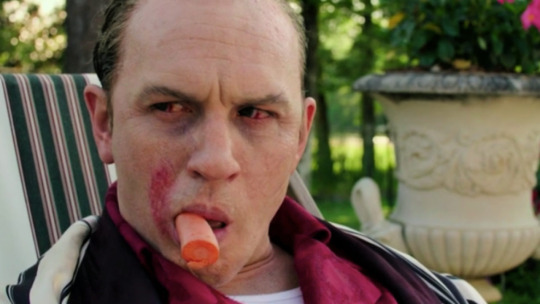
93. Capone (Josh Trank)- What is the point of this dinner theater trash? It takes place in the last year of Capone's life, when he was released from prison due to failing health and suffered a stroke in his Florida home. So it covers...none of the things that make Al Capone interesting? It's not historically accurate, which I have no problem with, but if you steer away from accuracy, then do something daring and exciting. Don't give me endless scenes of "Phonse"--as if the movie is running from the very person it's about--drawing bags of money that promise intrigue, then deliver nothing in return.
That being said, best "titular character shits himself" scene since The Judge.
92. Ammonite (Francis Lee)- I would say that this is the Antz to Portrait of a Lady on Fire's A Bug's Life, but it's actually more like the Cars 3 to Portrait of a Lady on Fire's Toy Story 1.
91. Ava (Tate Taylor)- Despite the mystery and inscrutability that usually surround assassins, what if we made a hitman movie but cared a lot about her personal life? Except neither the assassin stuff nor the family stuff is interesting?
90. Wonder Woman 1984 (Patty Jenkins)- What a miscalculation of what audiences loved about the first and wanted from the sequel. WW84 is silly and weightless in all of the ways that the first was elegant and confident. If the return of Pine is just a sort of phantom representation of Diana's desires, then why can he fly a real plane? If he is taking over another man's soul, then, uh, what ends up happening to that guy? For that matter, why is it not 1984 enough for Ronald Reagan to be president, but it is 1984 enough for the president to have so many Ronald Reagan signifiers that it's confusing? Why not just make a decision?
On paper, the me-first values of the '80s lend themselves to the monkey's paw wish logic of this plot. You could actually do something with the Star Wars program or the oil crisis. But not if the setting is played for only laughs and the screenplay explains only what it feels like.
89. Babyteeth (Shannon Murphy)- In this type of movie, there has to be a period of the Ben Mendelsohn character looking around befuddled about the new arrangement and going, "What's this now--he's going to be...living with us? The guy who tried to steal our medication? This is crazy!" But that's usually ten minutes, and in this movie it's an hour. I was so worn out by the end.
88. You Should Have Left (David Koepp)- David Koepp wrote Jurassic Park, so he's never going to hell, but how dare he start caring about his own mystery at the hour mark. There's a forty-five minute version of this movie that could get an extra star from me, and there's a three-hour version of Amanda Seyfried walking around in athleisure that would get four stars from me. What we actually get? No thanks.
87. Black Is King (Beyonce, et al.)- End your association with The Lion King, Bey. It has resulted in zero bops.
ADMIRABLE FAILURES

86. Birds of Prey (And the Fantabulous Emancipation of One Harley Quinn) (Cathy Yan)- There's nothing too dysfunctional in the storytelling or performances, but Birds of Prey also doesn't do a single thing well. I would prefer something alive and wild, even if it were flawed, to whatever tame belt-level formula this is.
85. The Turning (Floria Sigismondi)- This update of The Turn of the Screw pumps the age of Miles up to high school, which creates some horny creepiness that I liked. But the age of the character also prevents the ending of the novel from happening in favor of a truly terrible shrug. I began to think that all of the patience that the film showed earlier was just hesitance for its own awful ending.
I watched The Turning as a Mackenzie Davis Movie Star heat check, and while I'm not sure she has the magnetism I was looking for, she does have a great teacher voice, chastening but maternal.
84. Bloodshot (David Wilson)- A whole lot of Vin Diesel saying he's going to get revenge and kill a bunch of dudes; not a whole lot of Vin Diesel actually getting revenge and killing a bunch of dudes.
83. Downhill (Nat Faxon and Jim Rash)- I was an English major in college, which means I ended up locking myself into literary theories that, halfway through the writing of an essay, I realized were flawed. But rather than throw out the work that I had already proposed, I would just keep going and see if I could will the idea to success.
So let's say you have a theory that you can take Force Majeure by Ruben Ostlund, one of the best films of its year, and remake it so that its statement about familial anxiety could apply to Americans of the same age and class too...if it hadn't already. And maybe in the first paragraph you mess up by casting Will Ferrell and Julia Louis-Dreyfus, people we are conditioned to laugh at, when maybe this isn't that kind of comedy at all. Well, don't throw it away. You can quote more--fill up the pages that way--take an exact shot or scene from the original. Does that help? Maybe you can make the writing more vigorous and distinctive by adding a character. Is that going to make this baby stand out? Maybe you could make it more personal by adding a conclusion that is slightly more clever than the rest of the paper?
Or perhaps this is one you're just not going to get an A on.
82. Hillbilly Elegy (Ron Howard)- I watched this melodrama at my mother's encouragement, and, though I have been trying to pin down her taste for decades, I think her idea of a successful film just boils down to "a lot of stuff happens." So in that way, Ron Howard's loss is my gain, I guess.
There is no such thing as a "neutral Terminator."
81. Relic (Natalie Erika James)- The star of the film is Vanessa Cerne's set decoration, but the inert music and slow pace cancel out a house that seems neglected slowly over decades.
80. Buffaloed (Tanya Wexler)- Despite a breathless pace, Buffaloed can't quite congeal. In trying to split the difference between local color hijinks and Moneyballed treatise on debt collection, it doesn't commit enough to either one.
Especially since Zoey Deutch produced this one in addition to starring, I'm getting kind of worried about boo's taste. Lot of Two If by Seas; not enough While You Were Sleepings.
79. Like a Boss (Miguel Arteta)- I chuckled a few times at a game supporting cast that is doing heavy lifting. But Like a Boss is contrived from the premise itself--Yeah, what if people in their thirties fell out of friendship? Do y'all need a creative consultant?--to the escalation of most scenes--Why did they have to hide on the roof? Why do they have to jump into the pool?
The movie is lean, but that brevity hurts just as much as it helps. The screenplay knows which scenes are crucial to the development of the friendship, but all of those feel perfunctory, in a different gear from the setpieces.
To pile on a bit: Studio comedies are so bare bones now that they look like Lifetime movies. Arteta brought Chuck & Buck to Sundance twenty years ago, and, shot on Mini-DV for $250,000, it was seen as a DIY call-to-bootstraps. I guarantee that has more setups and locations and shooting days than this.
78. Eurovision Song Contest: The Story of Fire Saga (David Dobkin)- Add Dan Stevens to the list of supporting players who have bodied Will Ferrell in his own movie--one that he cared enough to write himself.
Like Downhill, Ferrell's other 2020 release, this isn't exactly bad. It's just workmanlike and, aside from the joke about Demi Lovato's "uninformed" ghost, frustratingly conventional.
77. The Traitor (Marco Bellochio)- Played with weary commitment by Pierfrancesco Favino, Tomasso Buscetta is "credited" as the first informant of La Cosa Nostra. And that sounds like an interesting subject for a "based on a true story" crime epic, right? Especially when you find out that Buscetta became a rat out of principle: He believed that the mafia to which he had pledged his life had lost its code to the point that it was a different organization altogether.
At no point does Buscetta waver or even seem to struggle with his decision though, so what we get is less conflicted than that description might suggest. None of these Italian mob movies glorify the lifestyle, so I wasn't expecting that. But if the crime doesn't seem enticing, and snitching on the crime seems like forlorn duty, and everything is pitched with such underhanded matter-of-factness that you can't even be sure when Buscetta has flipped, then what are we left with? It was interesting seeing how Italian courts work, I guess?
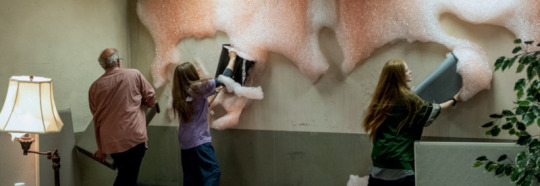
76. Kajillionaire (Miranda July)- This is another movie so intent on building atmosphere and lore that it takes too long to declare what it is. When the protagonist hits a breaking point and has to act, she has only a third of a film to grow. So whispery too.
Gina Rodriguez is the one to inject life into it. As soon as her motormouth winds up, the film slips into a different gear. The atmosphere and lore that I mentioned reeks of artifice, but her character is believably specific. Beneath a basic exterior is someone who is authentically caring but still morally compromised, beholden to the world that the other characters are suspicious of.
75. Scoob! (Tony Cervone)- The first half is sometimes clever, but it hammers home the importance of friendship while separating the friends.
The second half has some positive messaging, but your kids' movie might have a problem with scale if it involves Alexander the Great unlocking the gates of the Underworld.
My daughter loved it.
74. The Lovebirds (Michael Showalter)- If I start talking too much about this perfectly fine movie, I end up in that unfair stance of reviewing the movie I wanted, not what is actually there.* As a fan of hang-out comedies, I kind of resent that any comedy being made now has to be rolled into something more "exciting," whether it's a wrongfully accused or mistaken identity thriller or some other genre. Such is the post-Game Night world. There's a purposefully anti-climactic note that I wish The Lovebirds had ended on, but of course we have another stretch of hiding behind boats and shooting guns. Nanjiani and Rae are really charming leads though.
*- As a New Orleanian, I was totally distracted by the fake aspects of the setting too. "Oh, they walked to Jefferson from downtown? Really?" You probably won't be bothered by the locations.
73. Sonic the Hedgehog (Jeff Fowler)- In some ways the storytelling is ambitious. (I'm speaking for only myself, but I'm fine with "He's a hedgehog, and he's really fast" instead of the owl mother, teleportation backstory. Not everything has to be Tolkien.) But that ambition doesn't match the lack of ambition in the comedy, which depends upon really hackneyed setups and structures. Guiding Jim Carrey to full alrighty-then mode was the best choice anyone made.
72. Malcolm & Marie (Sam Levinson)- The stars move through these long scenes with agility and charisma, but the degree of difficulty is just too high for this movie to reach what it's going for.
Levinson is trying to capture an epic fight between a couple, and he can harness the theatrical intensity of such a thing, but he sacrifices almost all of the nuance. In real life, these knock-down-drag-outs can be circular and indirect and sad in a way that this couple's manipulation rarely is. If that emotional truth is all this movie is trying to achieve, I feel okay about being harsh in my judgment of how well it does that.
71. Beanpole (Kantemir Balagov)- Elusive in how it refuses to declare itself, forthright in how punishing it is. The whole thing might be worth it for a late dinner scene, but I'm getting a bit old to put myself through this kind of misery.
70. The Burnt Orange Heresy (Giuseppe Capotondi)- Silly in good ways until it's silly in bad ways. Elizabeth Debicki remains 6'3".
69. Everybody’s Everything (Sebastian Jones and Ramez Silyan)- As a person who listened to Lil Peep's music, I can confidently say that this documentary is overstating his greatness. His death was a significant loss, as the interview subjects will all acknowledge, but the documentary is more useful as a portrait of a certain unfocused, rapacious segment of a generation that is high and online at all times.
68. The Witches (Robert Zemeckis)- Robert Zemeckis, Kenya Barris, and Guillermo Del Toro are the credited screenwriters, and in a fascinating way, you can see the imprint of each figure on the final product. Adapting a very European story to the old wives' tales of the American South is an interesting choice. Like the Nicolas Roeg try at this material, Zemeckis is not afraid to veer into the terrifying, and Octavia Spencer's pseudo witch doctor character only sells the supernatural. From a storytelling standpoint though, it seems as if the obstacles are overcome too easily, as if there's a whole leg of the film that has been excised. The framing device and the careful myth-making of the flashback make promises that the hotel half of the film, including the abrupt ending, can't live up to.
If nothing else, Anne Hathaway is a real contender for Most On-One Performance of the year.
67. Irresistible (Jon Stewart)- Despite a sort of imaginative ending, Jon Stewart's screenplay feels more like the declarative screenplay that would get you hired for a good movie, not a good screenplay itself. It's provocative enough, but it's clumsy in some basic ways and never evades the easy joke.
For example, the Topher Grace character is introduced as a sort of assistant, then is re-introduced an hour later as a polling expert, then is shown coaching the candidate on presentation a few scenes later. At some point, Stewart combined characters into one role, but nothing got smoothed out.
ENDEARING CURIOSITIES WITH BIG FLAWS
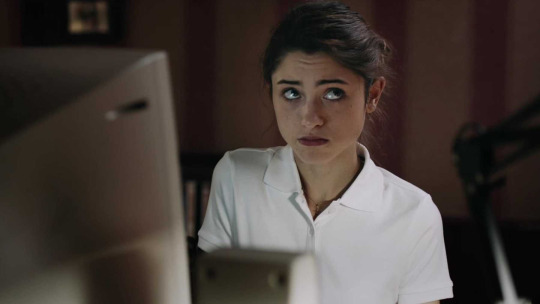
66. Yes, God, Yes (Karen Maine)- Most people who are Catholic, including me, are conflicted about it. Most people who make movies about being Catholic hate it and have an axe to grind. This film is capable of such knowing wit and nuance when it comes to the lived-in details of attending a high school retreat, but it's more concerned with taking aim at hypocrisy in the broad way that we've seen a million times. By the end, the film is surprisingly all-or-nothing when Christian teenagers actually contain multitudes.
Part of the problem is that Karen Maine's screenplay doesn't know how naive to make the Alice character. Sometimes she's reasonably naive for a high school senior in 2001; sometimes she's comically naive so that the plot can work; and sometimes she's stupid, which isn't the same as naive.
65. Bad Boys for Life (Adil El Arbi and Bilall Fallah)- This might be the first buddy cop movie in which the vets make peace with the tech-comm youngs who use new techniques. If that's the only novelty on display here--and it is--then maybe that's enough. I laughed maybe once. Not that the mistaken identity subplot of Bad Boys 1 is genius or anything, but this entry felt like it needed just one more layer to keep it from feeling as basic as it does. Speaking of layers though, it's almost impossible to watch any Will Smith movie now without viewing it through the meta-narrative of "What is Will Smith actually saying about his own status at this point in his career?" He's serving it up to us.
I derived an inordinate amount of pleasure from seeing the old school Simpson/Bruckheimer logo.
64. The Gentlemen (Guy Ritchie)- Look, I'm not going to be too negative on a movie whose crime slang is so byzantine that it has to be explained with subtitles. That's just me. I'm a simple man. But I can tell you that I tuned out pretty hard after seven or eight double-crosses.
The bloom is off the rose a bit for Ritchie, but he can still nail a music cue. I've been waiting for someone to hit "That's Entertainment" the way he does on the end credits.
63. Bad Hair (Justin Simien)- In Bad Hair, an African-American woman is told by her boss at a music video channel in 1989 that straightening her hair is the way to get ahead; however, her weave ends up having a murderous mind of its own. Compared to that charged, witty logline, the execution of the plot itself feels like a laborious, foregone conclusion. I'm glad that Simien, a genuinely talented writer, is making movies again though. Drop the skin-care routine, Van Der Beek!
62. Greyhound (Aaron Schneider)- "If this is the type of role that Tom Hanks writes for himself, then he understands his status as America's dad--'wise as the serpent, harmless as the dove'--even better than I thought."
"America's Dad! Aye aye, sir!"
"At least half of the dialogue is there for texture and authenticity, not there to be understood by the audience."
"Fifty percent, Captain!"
"The environment looks as fake as possible, but I eventually came around to the idea that the movie is completely devoid of subtext."
"No subtext to be found, sir!"
61. Mank (David Fincher)- About ten years ago, the Creative Screenwriting podcast spent an hour or so with James Vanderbilt, the writer of Zodiac and nothing else that comes close, as he relayed the creative paces that David Fincher pushed him through. Hundreds of drafts and years of collaborative work eventuated in the blueprint for Fincher's most exacting, personal film, which he didn't get a writing credit on only because he didn't seek one.
Something tells me that Fincher didn't ask for rewrites from his dead father. No matter what visuals and performances the director can coax from the script--and, to be clear, these are the worst visuals and performances of his career--they are limited by the muddy lightweight pages. There are plenty of pleasures, like the slippery election night montage or the shakily platonic relationship between Mank and Marion. But Fincher hadn't made a film in six years, and he came back serving someone else's master.
60. Tesla (Michael Almereyda)-
"You live inside your head."
"Doesn't everybody?"
As usual, Almereyda's deconstructions are invigorating. (No other moment can match the first time Eve Hewson's Anne fact-checks something with her anachronistic laptop.) But they don't add up to anything satisfying because Tesla himself is such an opaque figure. Driven by the whims of his curiosity without a clear finish line, the character gives Hawke something enigmatic to play as he reaches deep into a baritone. But he's too inward to lend himself to drama. Tesla feels of a piece with Almereyda's The Experimenter, and that's the one I would recommend.
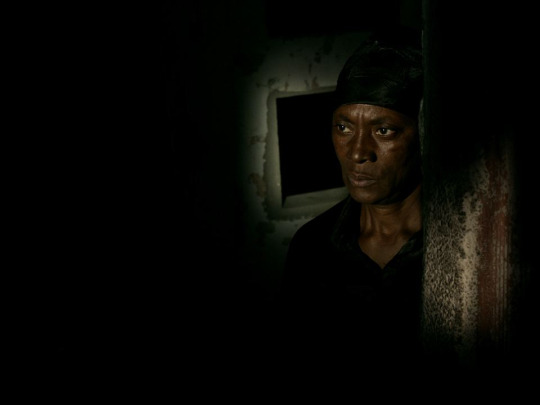
59. Vitalina Varela (Pedro Costa)- I can't oversell how delicately beautiful this film is visually. There's a scene in which Vitalina lugs a lantern into a church, but we get several seconds of total darkness before that one light source carves through it and takes over part of the frame. Each composition is as intricate as it is overpowering, achieving a balance between stark and mannered.
That being said, most of the film is people entering or exiting doors. I felt very little of the haunting loss that I think I was supposed to.
58. The Rhythm Section (Reed Morano)- Call it the Timothy Hutton in The General's Daughter Corollary: If a name-actor isn't in the movie much but gets third billing, then, despite whom he sends the protagonist to kill, he is the Actual Bad Guy.
Even if the movie serves up a lot of cliche, the action and sound design are visceral. I would like to see more from Morano.
57. Red, White and Blue (Steve McQueen)- Well-made and heartfelt even if it goes step-for-step where you think it will.
Here's what I want to know though: In the academy training sequence, the police cadets have to subdue a "berserker"; that is, a wildman who swings at their riot gear with a sledgehammer. Then they get him under control, and he shakes their hands, like, "Good angle you took on me there, mate." Who is that guy and where is his movie? Is this full-time work? Is he a police officer or an independent contractor? What would happen if this exercise didn't go exactly as planned?
56. Wolfwalkers (Tomm Moore and Ross Stewart)- The visuals have an unfinished quality that reminded me of The Tale of Princess Kaguya--the center of a flame is undrawn white, and fog is just negative space. There's an underlying symmetry to the film, and its color palette changes with mood.
Narratively, it's pro forma and drawn-out. Was Riley in Inside Out the last animated protagonist to get two parents? My daughter stuck with it, but she needed a lot of context for the religious atmosphere of 17th century Ireland.
55. What She Said: The Art of Pauline Kael (Rob Garver)- The film does little more than one might expect; it's limited in the way that any visual medium is when trying to sum up a woman of letters. But as far as education for Kael's partnership with Warren Beatty or the idea of The New Yorker paying her for only six months out of the year, it was useful for me.
Although Garver isn't afraid to point to the work that made Kael divisive, it would have been nice to have one or two interview subjects who questioned her greatness, rather than the crew of Paulettes who, even when they do say something like, "Sometimes I radically disagreed with her," do it without being able to point to any specifics.
54. Beastie Boys Story (Spike Jonze)- As far as this Spike Jonze completist is concerned, this is more of a Powerpoint presentation than a movie, Beastie Boys Story still warmed my heart, making me want to fire up Paul's Boutique again and take more pictures of my buddies.
53. Tenet (Christopher Nolan)- Cool and cold, tantalizing and frustrating, loud and indistinct, Tenet comes close to Nolan self-parody, right down to the brutalist architecture and multiple characters styled like him. The setpieces grabbed me, I'll admit.
Nolan's previous film, which is maybe his best, was "about" a lot and just happened to play with time; Tenet is only about playing with time.
PRETTY GOOD MOVIES
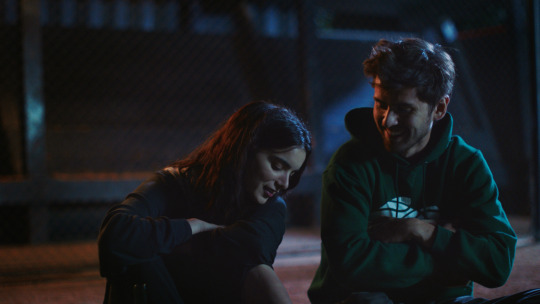
52. Shithouse (Cooper Raiff)- "Death is ass."
There's such a thing as too naturalistic. If I wanted to hear how college freshmen really talked, I would hang out with college freshmen. But you have to take the good verisimilitude with the bad, and good verisimilitude is the mother's Pod Save America t-shirt.
There are some poignant moments (and a gonzo performance from Logan Miller) in this auspicious debut from Cooper Raiff, the writer/director/editor/star. But the second party sequence kills some of the momentum, and at a crucial point, the characters spell out some motivation that should have stayed implied.
51. Totally Under Control (Alex Gibney, Ophelia Harutyunyan, Suzanne Hillinger)- As dense and informative as any other Gibney documentary with the added flex of making it during the pandemic it is investigating.
But yeah, why am I watching this right now? I don't need more reasons to be angry with Trump, whom this film calmly eviscerates. The directors analyze Trump's narcissism first through his contradictions of medical expertise in order to protect the economy that could win him re-election. Then it takes aim at his hiring based on loyalty instead of experience. But you already knew that, which is the problem with the film, at least for now.
50. Happiest Season (Clea Duvall)- I was in the perfect mood to watch something this frothy and bouncy. Every secondary character receives a moment in the sun, and Daniel Levy gets a speech that kind of saves the film at a tipping point.
I must say though: I wanted to punch Harper in her stupid face. She is a terrible romantic partner, abandoning or betraying Abby throughout the film and dissembling her entire identity to everyone else in a way that seems absurd for a grown woman in 2020. Run away, Kristen. Perhaps with Aubrey Plaza, whom you have more chemistry with. But there I go shipping and aligning myself with characters, which only proves that this is an effective romantic comedy.
49. The Way Back (Gavin O’Connor)- Patient but misshapen, The Way Back does just enough to overcome the cliches that are sort of unavoidable considering the genre. (I can't get enough of the parent character who, for no good reason, doesn't take his son's success seriously. "Scholarship? What he's gotta do is put his nose in them books! That's why I don't go to his games. [continues moving boxes while not looking at the other character] Now if you'll excuse me while I wait four scenes before showing up at a game to prove that I'm proud of him after all...")
What the movie gets really right or really wrong in the details about coaching and addiction is a total crap-shoot. But maybe I've said too much already.
48. The Whistlers (Corneliu Porumboiu)- Porumboiu is a real artist who seems to be interpreting how much surveillance we're willing to acknowledge and accept, but I won't pretend to have understood much of the plot, the chapters or which are told out of order. Sometimes the structure works--the beguiling, contextless "high-class hooker" sequence--but I often wondered if the film was impenetrable in the way that Porumboiu wanted it to be or impenetrable in the way he didn't.
To tell you the truth, the experience kind of depressed me because I know that, in my younger days, this film is the type of thing that I would re-watch, possibly with the chronology righted, knowing that it is worth understanding fully. But I have two small children, and I'm exhausted all the time, and I kind of thought I should get some credit for still trying to catch up with Romanian crime movies in the first place.
47. Borat Subsequent Moviefilm (Jason Woliner)- I laughed too much to get overly critical, but the film is so episodic and contrived that it's kind of exhausting by the end--even though it's achieving most of its goals. Maybe Borat hasn't changed, but the way our citizens own their ugliness has.
46. First Cow (Kelly Reichardt)- Despite how little happens in the first forty minutes, First Cow is a thoughtful capitalism parable. Even though it takes about forty minutes to get going, the friendship between Cookie and King-Lu is natural and incisive. Like Reichardt's other work, the film's modest premise unfolds quite gracefully, except for in the first forty minutes, which are uneventful.
45. Les Miserables (Ladj Ly)- I loved parts of the film--the disorienting, claustrophobic opening or the quick look at the police officers' home lives, for example. But I'm not sure that it does anything very well. The needle the film tries to thread between realism and theater didn't gel for me. The ending, which is ambiguous in all of the wrong ways, chooses the theatrical. (If I'm being honest, my expectations were built up by Les Miserables' Jury Prize at Cannes, and it's a bit superficial to be in that company.)
If nothing else, it's always helpful to see how another country's worst case scenario in law enforcement would look pretty good over here.
44. Bad Education (Cory Finley)- The film feels too locked-down and small at the beginning, so intent on developing the protagonist neutrally that even the audience isn't aware of his secrets. So when he faces consequences for those secrets, there's a disconnect. Part of tragedy is seeing the doom coming, right?
When it opens up, however, it's empathetic and subtle, full of a dry irony that Finley is already specializing in after only one other feature. Geraldine Viswanathan and Allison Janney get across a lot of interiority that is not on the page.
43. The Trip to Greece (Michael Winterbottom)- By the fourth installment, you know whether you're on board with the franchise. If you're asking "Is this all there is?" to Coogan and Brydon's bickering and impressions as they're served exotic food in picturesque settings, then this one won't sway you. If you're asking "Is this all there is?" about life, like they are, then I don't need to convince you.
I will say that The Trip to Spain seemed like an enervated inflection point, at which the squad could have packed it in. The Trip to Greece proves that they probably need to keep doing this until one of them dies, which has been the subtext all along.
42. Feels Good Man (Arthur Jones)- This documentary centers on innocent artist Matt Furie's helplessness as his Pepe the Frog character gets hijacked by the alt-right. It gets the hard things right. It's able to, quite comprehensively, trace a connection from 4Chan's use of Pepe the Frog to Donald Trump's near-assuming of Pepe's ironic deniability. Director Arthur Jones seems to understand the machinations of the alt-right, and he articulates them chillingly.
The easy thing, making us connect to Furie, is less successful. The film spends way too much time setting up his story, and it makes him look naive as it pits him against Alex Jones in the final third. Still, the film is a quick ninety-two minutes, and the highs are pretty high.
41. The Old Guard (Gina Prince-Bythewood)- Some of the world-building and backstory are handled quite elegantly. The relationships actually do feel centuries old through specific details, and the immortal conceit comes together for an innovative final action sequence.
Visually and musically though, the film feels flat in a way that Prince-Bythewood's other films do not. I blame Netflix specs. KiKi Layne, who tanked If Beale Street Could Talk for me, nearly ruins this too with the child-actory way that she stresses one word per line. Especially in relief with one of our more effortless actresses, Layne is distracting.
40. The Trial of the Chicago 7 (Aaron Sorkin)- Whenever Sacha Baron Cohen's Abbie Hoffman opens his mouth, the other defendants brace themselves for his dismissive vulgarity. Even when it's going to hurt him, he can't help but shoot off at the mouth. Of course, he reveals his passionate and intelligent depths as the trial goes on. The character is the one that Sorkin's screenplay seems the most endeared to: In the same way that Hoffman can't help but be Hoffman, Sorkin can't help but be Sorkin. Maybe we don't need a speech there; maybe we don't have to stretch past two hours; maybe a bon mot diffuses the tension. But we know exactly what to expect by now. The film is relevant, astute, witty, benevolent, and, of course, in love with itself. There are a handful of scenes here that are perfect, so I feel bad for qualifying so much.
A smaller point: Daniel Pemberton has done great work in the past (Motherless Brooklyn, King Arthur, The Man from U.N.C.L.E.), but the first sequence is especially marred by his sterile soft-rock approach.
GOOD MOVIES
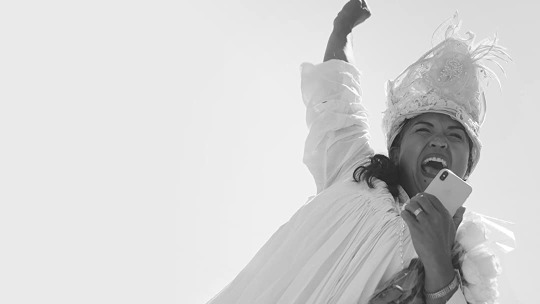
39. Time (Garrett Bradley)- The key to Time is that it provides very little context. Why the patriarch of this family is serving sixty years in prison is sort of besides the point philosophically. His wife and sons have to move on without him, and the tragedy baked into that fact eclipses any notion of what he "deserved." Feeling the weight of time as we switch back and forth between a kid talking about his first day of kindergarten and that same kid graduating from dentistry school is all the context we need. Time's presentation can be quite sumptuous: The drone shot of Angola makes its buildings look like crosses. Or is it X's?
At the same time, I need some context. When director Garrett Bradley withholds the reason Robert's in prison, and when she really withholds that Fox took a plea and served twelve years, you start to see the strings a bit. You could argue that knowing so little about why, all of a sudden, Robert can be on parole puts you into the same confused shoes as the family, but it feels manipulative to me. The film is preaching to the choir as far as criminal justice goes, which is fine, but I want it to have the confidence to tell its story above board.
38. Bloody Nose, Empty Pockets (Turner Ross and Bill Ross IV)- I have a barfly friend whom I see maybe once a year. When we first set up a time to meet, I kind of dread it and wonder what we'll have to talk about. Once we do get together, we trip on each other's words a bit, fumbling around with the rhythm of conversation that we mastered decades ago. He makes some kind of joke that could have been appropriate then but isn't now.
By the end of the day, hours later, we're hugging and maybe crying as we promise each other that we won't wait as long next time.
That's the exact same journey that I went on with this film.
37. Underwater (William Eubank)- Underwater is a story that you've seen before, but it's told with great confidence and economy. I looked up at twelve minutes and couldn't believe the whole table had been set. Kristen plays Ripley and projects a smart, benevolent poise.
36. The Lodge (Veronika Franz and Severin Fiala)- I prefer the grounded, manicured first half to the more fantastic second half. The craziness of the latter is only possible through the hard work of the former though. As with Fiala and Franz's previous feature, the visual rhymes and motifs get incorporated into the soup so carefully that you don't realize it until they overwhelm you in their bleak glory.
Small note: Alicia Silverstone, the male lead's first wife, and Riley Keough, his new partner, look sort of similar. I always think that's a nice note: "I could see how he would go for her."
35. Miss Americana (Lana Wilson)- I liked it when I saw it as a portrait of a person whose life is largely decided for her but is trying to carve out personal spaces within that hamster wheel. I loved it when I realized that describes most successful people in their twenties.
34. Sound of Metal (Darius Marder)- Riz Ahmed is showing up on all of the best performances of the year lists, but Sound of Metal isn't in anyone's top ten films of the year. That's about right. Ahmed's is a quiet, stubborn performance that I wish was in service of more than the straight line that we've seen before.
In two big scenes, there's this trick that Ahmed does, a piecing together of consequences with his eyes, as if he's moving through a flow chart in real time. In both cases, the character seems locked out and a little slower than he should be, which is, of course, why he's facing the consequences in the first place. To be charitable to a film that was a bit of a grind, it did make me notice a thing a guy did with his eyes.
33. Pieces of a Woman (Kornel Mundruczo)- Usually when I leave acting showcases like this, I imagine the film without the Oscar-baiting speeches, but this is a movie that specializes in speeches. Pieces of a Woman is being judged, deservedly so, by the harrowing twenty-minute take that opens the film, which is as indulgent as it is necessary. But if the unbroken take provides the "what," then the speeches provide the "why."
This is a film about reclaiming one's body when it rebels against you and when other people seek ownership of it. Without the Ellen Burstyn "lift your head" speech or the Vanessa Kirby show-stopper in the courtroom, I'm not sure any of that comes across.
I do think the film lets us off the hook a bit with the LaBoeuf character, in the sense that it gives us reasons to dislike him when it would be more compelling if he had done nothing wrong. Does his half-remembering of the White Stripes count as a speech?
32. Ma Rainey’s Black Bottom (George C. Wolfe)- This is such a play, not only in the locked-down location but also through nearly every storytelling convention: "Where are the two most interesting characters? Oh, running late? They'll enter separately in animated fashion?" But, to use the type of phrase that the characters might, "Don't hate the player; hate the game."
Perhaps the most theatrical note in this treatise on the commodification of expression is the way that, two or three times, the proceedings stop in their tracks for the piece to declare loudly what it's about. In one of those clear-outs, Boseman, who looks distractingly sick, delivers an unforgettable monologue that transports the audience into his character's fragile, haunted mind. He and Viola Davis are so good that the film sort of buckles under their weight, unsure of how to transition out of those spotlight moments and pretend that the story can start back up. Whatever they're doing is more interesting than what's being achieved overall.
31. Another Round (Thomas Vinterberg)- It's definitely the film that Vinterberg wanted to make, but despite what I think is a quietly shattering performance from Mikkelsen, Another Round moves in a bit too much of a straight line to grab me fully. The joyous final minutes hint at where it could have gone, as do pockets of Vinterberg's filmography, which seems newly tethered to realism in a way that I don't like. The best sequences are the wildest ones, like the uproarious trip to the grocery store for fresh cod, so I don't know why so much of it takes place in tiny hallways at magic hour. I give the inevitable American remake* permission to use these notes.
*- Just spitballing here. Martin: Will Ferrell, Nikolaj (Nick): Ben Stiller, Tommy: Owen Wilson, Peter: Craig Robinson
30. The Invisible Man (Leigh Whannell)- Exactly what I wanted. Exactly what I needed.
I think a less conclusive finale would have been better, but what a model of high-concept escalation. This is the movie people convinced me Whannell's Upgrade was.
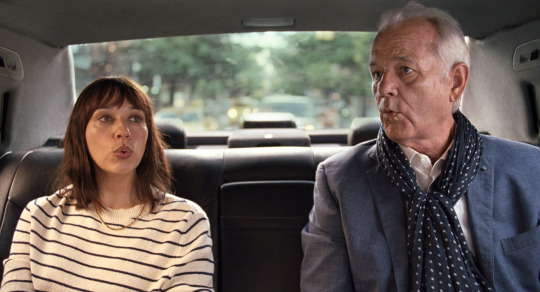
29. On the Rocks (Sofia Coppola)- Slight until the Mexican sojourn, which expands the scope and makes the film even more psychosexual than before. At times it feels as if Coppola is actively simplifying, rather than diving into the race and privilege questions that the Murray character all but demands.
As for Murray, is the film 50% worse without him? 70%? I don't know if you can run in supporting categories if you're the whole reason the film exists.
28. Mangrove (Steve McQueen)- The first part of the film seemed repetitive and broad to me. But once it settled in as a courtroom drama, the characterization became more shaded, and the filmmaking itself seemed more fluid. I ended up being quite outraged and inspired.
27. Shirley (Josephine Decker)- Josephine Decker emerges as a real stylist here, changing her foggy, impressionistic approach not one bit with a little more budget. Period piece and established actors be damned--this is still as much of a reeling fever dream as Madeline's Madeline. Both pieces are a bit too repetitive and nasty for my taste, but I respect the technique.
Here's my mandatory "Elisabeth Moss is the best" paragraph. While watching her performance as Shirley Jackson, I thought about her most famous role as Peggy on Mad Men, whose inertia and need to prove herself tied her into confidence knots. Shirley is almost the opposite: paralyzed by her worldview, certain of her talent, rejecting any empathy. If Moss can inhabit both characters so convincingly, she can do anything.
26. An American Pickle (Brandon Trost)- An American Pickle is the rare comedy that could actually use five or ten extra minutes, but it's a surprisingly heartfelt and wholesome stretch for Rogen, who is earnest in the lead roles.
25. The King of Staten Island (Judd Apatow)- At two hours and fifteen minutes, The King of Staten Island is probably the first Judd Apatow film that feels like the exact right length. For example, the baggy date scene between a gracious Bill Burr and a faux-dowdy Marisa Tomei is essential, the sort of widening of perspective that something like Trainwreck was missing.
It's Pete Davidson's movie, however, and though he has never been my cup of tea, I think he's actually quite powerful in his quiet moments. The movie probes some rare territory--a mentally ill man's suspicion that he is unlovable, a family's strategic myth-making out of respect for the dead. And when Davidson shows up at the firehouse an hour and fifteen minutes in, it feels as if we've built to a last resort.
24. Swallow (Carlo Mirabella-Davis)- The tricky part of this film is communicating Hunter's despair, letting her isolation mount, but still keeping her opaque. It takes a lot of visual discipline to do that, and Claudio Mirabella-Davis is up to the task. This ends up being a much more sympathetic, expressive movie than the plot description might suggest.
(In the tie dispute, Hunter and Richie are both wrong. That type of silk--I couldn't tell how pebbled it was, but it's probably a barathea weave-- shouldn't be ironed directly, but it doesn't have to be steamed. On a low setting, you could iron the back of the tie and be fine.)
23. The Vast of Night (Andrew Patterson)- I wanted a bit more "there" there; The film goes exactly where I thought it would, and there isn't enough humor for my taste. (The predictability might be a feature, not a bug, since the film is positioned as an episode of a well-worn Twilight Zone-esque show.)
But from a directorial standpoint, this is quite a promising debut. Patterson knows when to lock down or use silence--he even cuts to black to force us to listen more closely to a monologue. But he also knows when to fill the silence. There's a minute or so when Everett is spooling tape, and he and Fay make small talk about their hopes for the future, developing the characters' personalities in what could have been just mechanics. It's also a refreshingly earnest film. No one is winking at the '50s setting.
I'm tempted to write, "If Andrew Patterson can make this with $1 million, just imagine what he can do with $30 million." But maybe people like Shane Carruth have taught us that Patterson is better off pinching pennies in Texas and following his own muse.
22. Martin Eden (Pietro Marcello)- At first this film, adapted from a picaresque novel by Jack London, seemed as if it was hitting the marks of the genre. "He's going from job to job and meeting dudes who are shaping his worldview now." But the film, shot in lustrous Super 16, won me over as it owned the trappings of this type of story, forming a character who is a product of his environment even as he transcends it. By the end, I really felt the weight of time.
You want to talk about something that works better in novels than films though? When a passionate, independent protagonist insists that a woman is the love of his life, despite the fact that she's whatever Italians call a wet blanket. She's rich, but Martin doesn't care about her money. He hates her family and friends, and she refuses to accept him or his life pursuits. She's pretty but not even as pretty as the waitress they discuss. Tell me what I'm missing here. There's archetype, and there's incoherence.
21. Bacurau (Kleber Mendonca Filho and Juliano Dornelles)- Certain images from this adventurous film will stick with me, but I got worn out after the hard reset halfway through. As entranced as I was by the mystery of the first half, I think this blood-soaked ensemble is better at asking questions than it is at answering them.
20. Let Them All Talk (Steven Soderbergh)- The initial appeal of this movie might be "Look at these wonderful actresses in their seventies getting a movie all to themselves." And the film is an interesting portrait of ladies taking stock of relationships that have spanned decades. But Soderbergh and Eisenberg handle the twentysomething Lucas Hedges character with the same openness and empathy. His early reasoning for going on the trip is that he wants to learn from older women, and Hedges nails the puppy-dog quality of a young man who would believe that. Especially in the scenes of aspirational romance, he's sweet and earnest as he brushes his hair out of his face.
Streep plays Alice Hughes, a serious author of literary fiction, and she crosses paths with Kelvin Kranz, a grinder of airport thrillers. In all of the right ways, Let Them All Talk toes the line between those two stances as an entertaining, jaunty experiment that also shoulders subtextual weight. If nothing else, it's easy to see why a cruise ship's counterfeit opulence, its straight lines at a lean, would be visually engaging to Soderbergh. You can't have a return to form if your form is constantly evolving.

19. Dick Johnson Is Dead (Kirsten Johnson)- Understandably, I don't find the subject as interesting as his own daughter does, and large swaths of this film are unsure of what they're trying to say. But that's sort of the point, and the active wrestling that the film engages in with death ultimately pays off in a transcendent moment. The jaw-dropping ending is something that only non-fiction film can achieve, and Johnson's whole career is about the search for that sort of serendipity.
18. Da 5 Bloods (Spike Lee)- Delroy Lindo is a live-wire, but his character is the only one of the principals who is examined with the psychological depth I was hoping for. The first half, with all of its present-tense flourishes, promises more than the gunfights of the second half can deliver. When the film is cooking though, it's chock full of surprises, provocations, and pride.
17. Never Rarely Sometimes Always (Eliza Hittmann)- Very quickly, Eliza Hittmann has established herself as an astute, empathetic director with an eye for discovering new talent. I hope that she gets to make fifty more movies in which she objectively follows laconic young people. But I wanted to like this one more than I did. The approach is so neutral that it's almost flat to me, lacking the arc and catharsis of her previous film, Beach Rats. I still appreciate her restraint though.
GREAT MOVIES
16. Young Ahmed (Jean-Pierre Dardenne and Luc Dardenne)- I don't think the Dardennes have made a bad movie yet, and I'm glad they turned away from the slight genre dipping of The Unknown Girl, the closest to bad that they got. Young Ahmed is a lean, daring return to form.
Instead of following an average person, as they normally do, the Dardenne Brothers follow an extremist, and the objectivity that usually generates pathos now serves to present ambiguity. Ahmed says that he is changing, that he regrets his actions, but we never know how much of his stance is a put-on. I found myself wanting him to reform, more involved than I usually am in these slices of life. Part of it is that Idir Ben Addi looks like such a normal, young kid, and the Ahmed character has most of the qualities that we say we want in young people: principles, commitment, self-worth, reflection. So it's that much more destructive when those qualities are used against him and against his fellow man.
15. World of Tomorrow Episode Three: The Absent Destinations of David Prime (Don Hertzfeldt)- My dad, a man whom I love but will never understand, has dismissed modern music before by claiming that there are only so many combinations of chords. To him, it's almost impossible to do something new. Of course, this is the type of thing that an uncreative person would say--a person not only incapable of hearing the chords that combine notes but also unwilling to hear the space between the notes. (And obviously, that's the take of a person who doesn't understand that, originality be damned, some people just have to create.)
Anyway, that attitude creeps into my own thinking more than I would like, but then I watch something as wholly original as World of Tomorrow Episode Three. The series has always been a way to pile sci-fi ideas on top of each other to prove the essential truths of being and loving. And this one, even though it achieves less of a sense of yearning than its predecessor, offers even more devices to chew on. Take, for example, the idea that Emily sends her message from the future, so David's primitive technology can barely handle it. In order to move forward with its sophistication, he has to delete any extraneous skills for the sake of computer memory. So out of trust for this person who loves him, he has to weigh whether his own breathing or walking can be uninstalled as a sacrifice for her. I thought that we might have been done describing love, but there it is, a new metaphor. Mixing futurism with stick figures to get at the most pure drive possible gave us something new. It's called art, Dad.
14. On the Record (Kirby Dick and Amy Ziering)- We don't call subjects of documentaries "stars" for obvious reasons, but Drew Dixon kind of is one. Her honesty and wisdom tell a complete story of the #MeToo movement. Kirby Dick and Amy Ziering take their time developing her background at first, not because we need to "gain sympathy" or "establish credibility" for a victim of sexual abuse, but because showing her talent and enthusiasm for hip-hop A&R makes it that much more tragic when her passion is extinguished. Hell, I just like the woman, so spending a half-hour on her rise was pleasurable in and of itself.
This is a gut-wrenching, fearless entry in what is becoming Dick and Ziering's raison d'etre, but its greatest quality is Dixon's composed reflection. She helped to establish a pattern of Russell Simmons's behavior, but she explains what happened to her in ways I had never heard before.
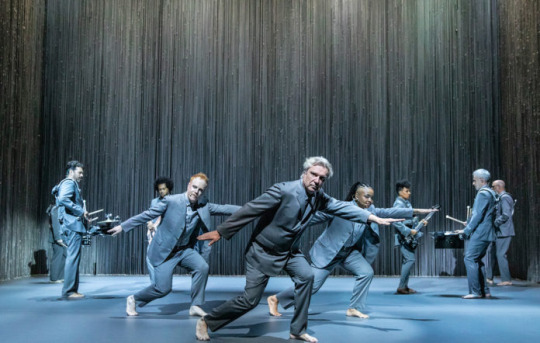
13. David Byrne’s American Utopia (Spike Lee)- I'm often impressed by the achievements that puzzle me: How did they pull that off? But I know exactly how David Byrne pulled off the impish but direct precision of American Utopia: a lot of hard work.
I can't blame Spike Lee for stealing a page from Demme's Stop Making Sense: He denies us a close-up of any audience members until two-thirds of the way through, when we get someone in absolute rapture.
12. One Night in Miami... (Regina King)- We've all cringed when a person of color is put into the position of speaking on behalf of his or her entire race. But the characters in One Night in Miami... live in that condition all the time and are constantly negotiating it. As Black public figures in 1964, they know that the consequences of their actions are different, bigger, than everyone else's. The charged conversations between Malcolm X and Sam Cooke are not about whether they can live normal lives. They're way past that. The stakes are closer to Sam Cooke arguing that his life's purpose aligns with the protection and elevation of African-Americans while Malcolm X argues that those pursuits should be the same thing. Late in the movie, Cassius Clay leaves the other men, a private conversation, to talk to reporters, a public conversation. But the film argues that everything these men do is always already public. They're the most powerful African-Americans in the country, but their lives are not their own. Or not only their own.
It's true that the first act has the clunkiness and artifice of a TV movie, but once the film settles into the motel room location and lets the characters feed off one another, it's gripping. It's kind of unfair for a movie to get this many scenes of Leslie Odom Jr. singing, but I'll take it.
11. Saint Frances (Alex Thompson)- Rilke wrote, "Perhaps everything terrible is in its deepest being something helpless that wants help from us." The characters' behavior in Saint Frances--all of these fully formed characters' behavior--made me think of that quotation. When they lash out at one another, even at their nastiest, the viewer has a window into how they're expressing pain they can't verbalize. The film is uneven in its subtlety, but it's a real showcase for screenwriter and star Kelly O'Sullivan, who is unflinching and dynamic in one of the best performances of the year. Somebody give her some of the attention we gave to Zach Braff for God's sake.
10. Boys State (Jesse Moss and Amanda McBaine)- This documentary is kind of a miracle from a logistical standpoint. From casting interviews beforehand, lots of editing afterwards, or sly note-taking once the conference began, McBaine and Moss happened to select the four principals who mattered the most at the convention, then found them in rooms full of dudes wearing the same tucked-in t-shirt. By the way, all of the action took place over the course of one week, and by definition, the important events are carved in half.
To call Boys State a microcosm of American politics is incorrect. These guys are forming platforms and voting in elections. What they're doing is American politics, so when they make the same compromises and mistakes that active politicians do, it produces dread and disappointment. So many of the boys are mimicking the political theater that they see on TV, and that sweaty sort of performance is going to make a Billy Mitchell out of this kid Ben Feinstein, and we'll be forced to reckon with how much we allow him to evolve as a person. This film is so precise, but what it proves is undeniably messy. Luckily, some of these seventeen-year-olds usher in hope for us all.
If nothing else, the film reveals the level to which we're all speaking in code.
9. The Nest (Sean Durkin)- In the first ten minutes or so of The Nest, the only real happy minutes, father and son are playing soccer in their quaint backyard, and the father cheats to score on a children's net before sliding on the grass to rub in his victory. An hour later, the son kicks the ball around by himself near a regulation goal on the family's massive property. The contrast is stark and obvious, as is the symbolism of the dead horse, but that doesn't mean it's not visually powerful or resonant.
Like Sean Durkin's earlier film, Martha Marcy May Marlene, the whole of The Nest is told with detail of novelistic scope and an elevation of the moment. A snippet of radio that mentions Ronald Reagan sets the time period, rather than a dateline. One kid saying "Thanks, Dad" and another kid saying, "Thanks, Rory" establishes a stepchild more elegantly than any other exposition might.
But this is also a movie that does not hide what it means. Characters usually say exactly what is on their minds, and motivations are always clear. For example, Allison smokes like a chimney, so her daughter's way of acting out is leaving butts on the window sill for her mother to find. (And mother and daughter both definitely "act out" their feelings.) On the other hand, Ben, Rory's biological son, is the character least like him, so these relationships aren't too directly parallel. Regardless, Durkin uses these trajectories to cast a pall of familial doom.
8. Sorry We Missed You (Sean Durkin)- Another precisely calibrated empathy machine from Ken Loach. The overwhelmed matriarch, Abby, is a caretaker, and she has to break up a Saturday dinner to rescue one of her clients, who wet herself because no one came to help her to the bathroom. The lady is embarrassed, and Abby calms her down by saying, "You mean more to me than you know." We know enough about Abby's circumstances to realize that it's sort of a lie, but it's a beautiful lie, told by a person who cares deeply but is not cared for.
Loach's central point is that the health of a family, something we think of as immutable and timeless, is directly dependent upon the modern industry that we use to destroy ourselves. He doesn't have to be "proven" relevant, and he didn't plan for Covid-19 to point to the fragility of the gig economy, but when you're right, you're right.
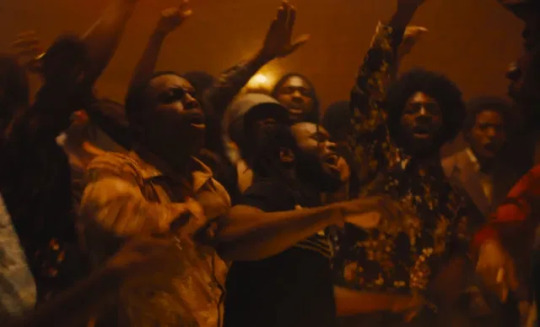
7. Lovers Rock (Steve McQueen)- swear to you I thought: "This is an impeccable depiction of a great house party. The only thing it's missing is the volatile dude who scares away all the girls." And then the volatile dude who scares away all the girls shows up.
In a year short on magic, there are two or three transcendent moments, but none of them can equal the whole crowd singing along to "Silly Games" way after the song has ended. Nothing else crystallizes the film's note of celebration: of music, of community, of safe spaces, of Black skin. I remember moments like that at house parties, and like all celebrations, they eventually make me sad.
6. Crip Camp: A Disability Revolution (Nicole Newnham and James Lebrecht)- I held off on this movie because I thought that I knew what it was. The setup was what I expected: A summer camp for the disabled in the late '60s takes on the spirit of the time and becomes a haven for people who have not felt agency, self-worth, or community anywhere else. But that's the right-place-right-time start of a story that takes these figures into the '80s as they fight for their rights.
If you're anything like my dumb ass, you know about 504 accommodations from the line on a college syllabus that promises equal treatment. If 2020 has taught us anything though, it's that rights are seized, not given, and this is the inspiring story of people who unified to demand what they deserved. Judy Heumann is a civil rights giant, but I'm ashamed to say I didn't know who she was before this film. If it were just a history lesson that wasn't taught in school, Crip Camp would still be valuable, but it's way more than that.
5. Palm Springs (Max Barbakow)- When explaining what is happening to them, Andy Samberg's Nyles twirls his hand at Cristin Milioti's Sara and says, "It's one of those infinite time-loop scenarios." Yeah, one of those. Armed with only a handful of fictional examples, she and the audience know exactly what he means, and the continually inventive screenplay by Andy Siara doesn't have to do any more explaining. In record time, the film accelerates into its premise, involves her, and sets up the conflict while avoiding the claustrophobia of even Groundhog Day. That economy is the strength that allows it to be as funny as it is. By being thrifty with the setup, the savings can go to, say, the couple crashing a plane into a fiery heap with no consequences.
In some accidental ways, this is, of course, a quarantine romance as well. Nyles and Sara frustratingly navigate the tedious wedding as if they are play-acting--which they sort of are--then they push through that sameness to grow for each other, realizing that dependency is not weakness. The best relationships are doing the same thing right now.
Although pointedly superficial--part of the point of why the couple is such a match--and secular--I think the notion of an afterlife would come up at least once--Palm Springs earns the sincerity that it gets around to. And for a movie ironic enough to have a character beg to be impaled so that he doesn't have to sit in traffic, that's no small feat.
4. The Assistant (Kitty Green)- A wonder of Bressonian objectivity and rich observation, The Assistant is the rare film that deals exclusively with emotional depth while not once explaining any emotions. One at a time, the scrape of the Kleenex box might not be so grating, the long hallway trek to the delivery guy might not be so tiring, but this movie gets at the details of how a job can destroy you in ways that add up until you can't even explain them.
3. Promising Young Woman (Emerald Fennell)- In her most incendiary and modern role, Carey Mulligan plays Cassie, which is short for Cassandra, that figure doomed to tell truths that no one else believes. The web-belted boogeyman who ruined her life is Al, short for Alexander, another Greek who is known for his conquests. The revenge story being told here--funny in its darkest moments, dark in its funniest moments--is tight on its surface levels, but it feels as if it's telling a story more archetypal and expansive than that too.
An exciting feature debut for its writer-director Emerald Fennell, the film goes wherever it dares. Its hero has a clear purpose, and it's not surprising that the script is willing to extinguish her anger halfway through. What is surprising is the way it renews and muddies her purpose as she comes into contact with half-a-dozen brilliant one- or two-scene performances. (Do you think Alfred Molina can pull off a lawyer who hates himself so much that he can't sleep? You would be right.)
Promising Young Woman delivers as an interrogation of double standards and rape culture, but in quiet ways it's also about our outsized trust in professionals and the notion that some trauma cannot be overcome.
INSTANT CLASSICS
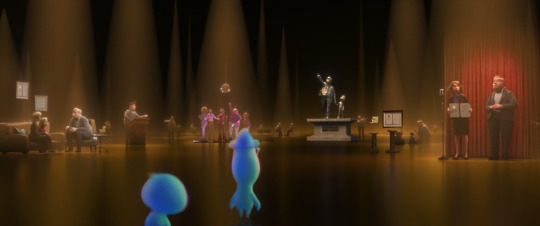
2. Soul (Pete Docter)- When Pete Docter's Up came out, it represented a sort of coronation for Pixar: This was the one that adults could like unabashedly. The one with wordless sequences and dead children and Ed Asner in the lead. But watching it again this week with my daughter, I was surprised by how high-concept and cloying it could be. We choose not to remember the middle part with the goofy dog stuff.
Soul is what Up was supposed to be: honest, mature, stirring. And I don't mean to imply that a family film shouldn't make any concessions to children. But Soul, down to the title, never compromises its own ambition. Besides Coco, it's probably the most credible character study that Pixar has ever made, with all of Joe's growth earned the hard way. Besides Inside Out, it's probably the wittiest comedy that Pixar has ever made, bursting with unforced energy.
There's a twitter fascination going around about Dez, the pigeon-figured barber character whose scene has people gushing, "Crush my windpipe, king" or whatever. Maybe that's what twitter does now, but no one fantasized about any characters in Up. And I count that as progress.
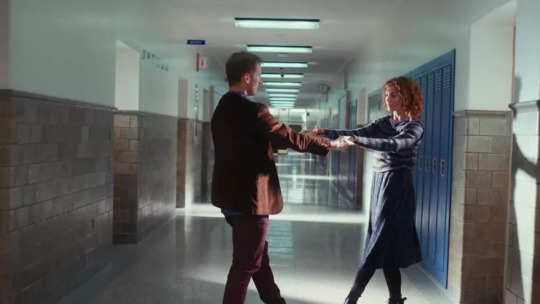
1. I’m Thinking of Ending Things (Charlie Kaufman)- After hearing that our name-shifting protagonist moonlights as an artist, a no-nonsense David Thewlis offers, "I hope you're not an abstract artist." He prefers "paintings that look like photographs" over non-representational mumbo-jumbo. And as Jessie Buckley squirms to try to think of a polite way to talk back, you can tell that Charlie Kaufman has been in the crosshairs of this same conversation. This morose, scary, inscrutable, expressionist rumination is not what the Netflix description says it is at all, and it's going to bother nice people looking for a fun night in. Thank God.
The story goes that Steven Spielberg and George Lucas, when constructing Raiders of the Lost Ark, sought to craft a movie that was "only the good parts" with little of the clunky setup that distracted from action. What we have here is a Charlie Kaufman movie with only the Charlie Kaufman moments, less interested than ever before at holding one's hand. The biting humor is here, sometimes aimed at philistines like the David Thewlis character above, sometimes at the niceties that we insist upon. The lonely horror of everyday life is here, in the form of missed calls from oneself or the interruption of an inner monologue. Of course, communicating the overwhelming crush of time, both unknowable and familiar, is the raison d'etre.
A new pet motif seems to be the way that we don't even own our own knowledge. The Young Woman recites "Bonedog" by Eva H.D., which she claims/thinks she wrote, only to find Jake's book open to that page, next to a Pauline Kael book that contains a Woman Under the Influence review that she seems to have internalized later. When Jake muses about Wordsworth's "Lucy Poems," it starts as a way to pass the time, then it becomes a way to lord his education over her, then it becomes a compliment because the subject resembles her, then it becomes a way to let her know that, in the grand scheme of things, she isn't that special at all. This film jerks the viewer through a similar wintry cycle and leaves him with his own thoughts. It's not a pretty picture, but it doesn't look like anything else.
8 notes
·
View notes
Note
Whats your opinion on Steve's apparently strained relationship with his dad? And how this could've possibly shaped his former bully persona and the facade he used to put on in S1? I know theres very little to go on in canon about his dad but i'd love to hear your thoughts...
Okay, I’ve been sitting on this for a while because I was trying to think honestly about this and separate what I think is likely from what my own personal headcanons are, as well as the common headcanons a lot of the fandom shares for Steve.
I think Steve’s dad isn’t a bad guy, at least, not openly abusive. I don’t even think he’s all that emotionally abusive. I think he’s a very traditional man, very much entrenched in the idea that the husband goes out and earns the money while the wife stays home and raises the children, and those children are expected to be well behaved, obedient, and good at both academics and sports. A very proper 1950s family. The problem is that this is the 80s, a time of rampant greed and pro-capitalist propaganda. Greed is good! The 80s were a very image-conscious era, very much concerned with making as much money as possible and projecting out an image of wealth and success, and Mr. Harrington was ALL ABOUT THIS.
I think the first problem comes in when Mrs. Harrington is not well suited to this life. I don’t think she would like being in a small town like Hawkins. I think she would desire more of a social atmosphere, a place where she could be involved in charities and auxiliaries and womens’ social clubs. I think in Hawkins she finds herself bored and unoccupied. I think she loves Steve, but isn’t great at motherhood. She more or less leaves him to his own devices and doesn’t much understand her son. She feels alienated and alone and subconsciously she is perhaps resentful. When Steve is finally old enough to be left alone she travels with her husband on business trips to keep him in line. This shows that there is no trust in this marriage and it’s an openly known fact that Mr. Harrington cheats.
The next problem is that Steve isn’t at all academically inclined. Now, I admit that I think it’s partially due to an undiagnosed learning disorder, but ultimately that doesn’t matter. His father has his own ideas as to why Steve isn’t pulling the grades he thinks his son should be, and they mostly boil down to laziness. A learning disorder doesn’t fit with his view of a perfect family, so he can’t even conceptualize that Steve might have one. He can see Steve as just not trying hard enough to live up to his potential though. From Mr. Harrington’s point of view he’s given Steve everything he needs to succeed: a nice home, all the best school supplies, nutritious food, the best clothes, and anything else that has a clear monetary cost attached to it. Love and attention don’t fit his idea of being a father, he’s only there to provide and discipline. His role is to be the one to mold his son into a man, and that means he has to force Steve to act and behave certain ways.
This is where we get King Steve from. I have written extensively that I don’t actually see Steve as having been a bully, he was more of that rich douche, the clueless trendsetter that others flock to because of his wealth and ability to raise their positions in the social hierarchy. Steve also possesses a natural charisma (or rather, Joe does, and Steve got the benefit of that) that draws people in. Unfortunately this has the problem of drawing in the type of people who want to use others to their own benefit, to advance themselves. Steve is desperate for meaningful connections with people due to his lack of parental attention, and as such willingly goes along with people who aren’t a good influence on him but who make him feel validated and appreciated. He basically lets Tommy and Carol call the shots and only gives token protests when they’re making hurtful or bullying statements. He doesn’t want to rock the boat too much and find out that he doesn’t have as much power as it would appear from the outside. He acts in the confident, self-aggrandizing manner that further projects the image his father wants the family to be seen as. To this length he even bought his sixteen year old son a super super expensive car, an ultimate demonstration that they have so much money he can waste it like this on his kid who is only learning to drive. I can’t even begin to imagine what Steve’s insurance must cost per month!
So yes, ultimately most of who we first see Steve as is a reflection of his highly successful, but emotionally absent father. It’s about portraying that image to the best of his ability when in public. In the very first episode we see that when Steve is in private with Nancy he’s actually a big ol’ dork. He’s also pretty respectful for a horny teenage boy, not too pushy about the making out. When Nancy seriously tells him to stop he picks the flashcards back up and gets back on task. He’s a good kid on the inside, but is being pressured by his family and his ‘friends’ into the image of a slick, womanizing, jock, one who only cares about himself. Not to say that Steve can’t be selfish, as he definitely is at times, but that also comes from his unbringing and problems relating to his father. He is legitimately worried about his father finding out about his party, despite said party being four kids and a couple of beers. Like, that...that isn’t a party?? I get why any kid would be worried, but ultimately it’s not like he threw a giant shindig and destroyed his house.
I think after his fight with Jonathan, Steve realizes something. I think the words he threw at Jonathan are the sort of words he’s heard from his father before, the type of disapproving gossip the elder Harringtons would talk derisively about at the dinner table, the one time of day the family is actually together. I think Steve suddenly realizes that he’s being a version of his dad, that he’s on a path that leads to becoming him for real. He realizes his friends are actively encouraging this transformation. I honestly think Steve really dislikes his dad, not just for neglecting Steve and never trying to forge a connection with him, but also for how the man’s treatment has affected his wife, how his infidelities have turned her bitter and untrusting. Steve got upset at Jonathan and Nancy because he thought they were cheating, and that’s something Steve can’t tolerate. It’s pretty much the ultimate betrayal and I think it’s probably where most of his derision for his father comes from. He’s more easily upset on the behalf of others than on his own behalf. He resents his father for not loving his mother enough to be faithful to her. So he lashes out when he thinks he’s been treated the same way, only to realize that it made him act more like his father than ever. This took him aback to the point that he turned his back on the people who had been his ‘friends’, and caused him to make the most impressive and nature decision that he ever has: he apologized. Like, that legitimately awed me. It is so hard to admit when we’re wrong, even privately to ourselves. For Steve to admit that and want to actually fix it, to go to the person he’d hurt and tell them he was wrong? That really shows the kind of person that Steve is on the inside. Who he is when stripped of his artifices. A person with a huge heart that truly cares what others think of him and who wants to be liked for the right reasons, but who sometimes fucks up because he was never given positive demonstrations of how to be that person.
Tl;dr Steve’s dad is a emotionally absent traditionalist who resents his dumb son, and his mom is a bored housewife who takes any opportunity to find something to distract her from her dull day to day existence. His father’s cheating greatly affected Steve and built a wedge of resentment between them, further destroying their chances at a meaningful relationship. Somehow they produced a son who has a huge heart and a desire to be loved, but who never had the encouragement or tools to express this and was instead led down a path of bad behaviour by those who wanted to exploit the Harringtons’ ‘perfect’ image.
#Steve Harrington#Steve Harrington’s parents#i did my best to keep it grounded in fact but honestly?#the show has given us so little information about Steve that it’s hard#most of what i present here i extrapolate from his behaviour towards cheating#Stranger Things#my meta#this was a looong one sorry!!#but like i can go on and on about Steve for a while
41 notes
·
View notes